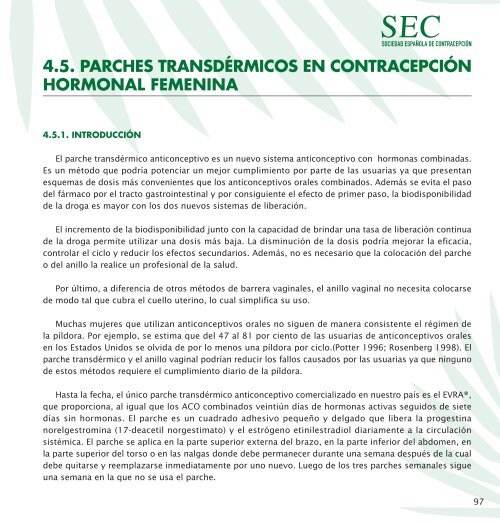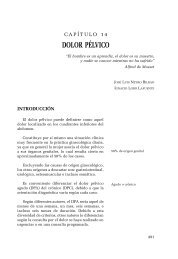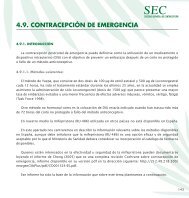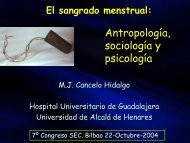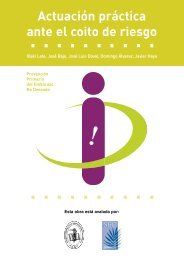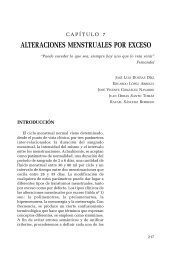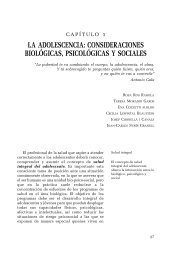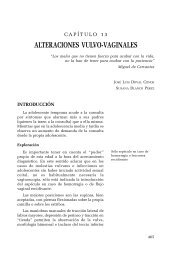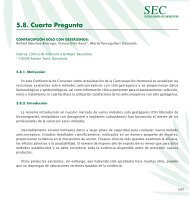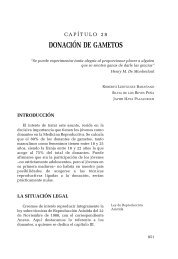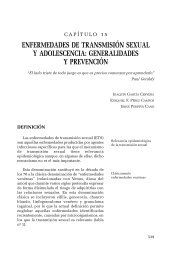4.5. parches transdérmicos en contracepción hormonal femenina
4.5. parches transdérmicos en contracepción hormonal femenina
4.5. parches transdérmicos en contracepción hormonal femenina
You also want an ePaper? Increase the reach of your titles
YUMPU automatically turns print PDFs into web optimized ePapers that Google loves.
SOCIEDAD ESPAÑOLA DE CONTRACEPCIÓN<br />
<strong>4.5.</strong> PARCHES TRANSDÉRMICOS EN CONTRACEPCIÓN<br />
HORMONAL FEMENINA<br />
<strong>4.5.</strong>1. INTRODUCCIÓN<br />
El parche transdérmico anticonceptivo es un nuevo sistema anticonceptivo con hormonas combinadas.<br />
Es un método que podría pot<strong>en</strong>ciar un mejor cumplimi<strong>en</strong>to por parte de las usuarias ya que pres<strong>en</strong>tan<br />
esquemas de dosis más conv<strong>en</strong>i<strong>en</strong>tes que los anticonceptivos orales combinados. Además se evita el paso<br />
del fármaco por el tracto gastrointestinal y por consigui<strong>en</strong>te el efecto de primer paso, la biodisponibilidad<br />
de la droga es mayor con los dos nuevos sistemas de liberación.<br />
El increm<strong>en</strong>to de la biodisponibilidad junto con la capacidad de brindar una tasa de liberación continua<br />
de la droga permite utilizar una dosis más baja. La disminución de la dosis podría mejorar la eficacia,<br />
controlar el ciclo y reducir los efectos secundarios. Además, no es necesario que la colocación del parche<br />
o del anillo la realice un profesional de la salud.<br />
Por último, a difer<strong>en</strong>cia de otros métodos de barrera vaginales, el anillo vaginal no necesita colocarse<br />
de modo tal que cubra el cuello uterino, lo cual simplifica su uso.<br />
Muchas mujeres que utilizan anticonceptivos orales no sigu<strong>en</strong> de manera consist<strong>en</strong>te el régim<strong>en</strong> de<br />
la píldora. Por ejemplo, se estima que del 47 al 81 por ci<strong>en</strong>to de las usuarias de anticonceptivos orales<br />
<strong>en</strong> los Estados Unidos se olvida de por lo m<strong>en</strong>os una píldora por ciclo.(Potter 1996; Ros<strong>en</strong>berg 1998). El<br />
parche transdérmico y el anillo vaginal podrían reducir los fallos causados por las usuarias ya que ninguno<br />
de estos métodos requiere el cumplimi<strong>en</strong>to diario de la píldora.<br />
Hasta la fecha, el único parche transdérmico anticonceptivo comercializado <strong>en</strong> nuestro país es el EVRA®,<br />
que proporciona, al igual que los ACO combinados veintiún días de hormonas activas seguidos de siete<br />
días sin hormonas. El parche es un cuadrado adhesivo pequeño y delgado que libera la progestina<br />
norelgestromina (17-deacetil norgestimato) y el estróg<strong>en</strong>o etinilestradiol diariam<strong>en</strong>te a la circulación<br />
sistémica. El parche se aplica <strong>en</strong> la parte superior externa del brazo, <strong>en</strong> la parte inferior del abdom<strong>en</strong>, <strong>en</strong><br />
la parte superior del torso o <strong>en</strong> las nalgas donde debe permanecer durante una semana después de la cual<br />
debe quitarse y reemplazarse inmediatam<strong>en</strong>te por uno nuevo. Luego de los tres <strong>parches</strong> semanales sigue<br />
una semana <strong>en</strong> la que no se usa el parche.<br />
97
98<br />
SOCIEDAD ESPAÑOLA DE CONTRACEPCIÓN<br />
Algunas de las posibles desv<strong>en</strong>tajas de estos nuevos métodos anticonceptivos de liberación incluy<strong>en</strong><br />
la inhibición incompleta de la ovulación, el control subóptimo del ciclo y el despr<strong>en</strong>dimi<strong>en</strong>to espontáneo<br />
del parche transdérmico o la expulsión del anillo vaginal. Además, el anillo ti<strong>en</strong>e la pot<strong>en</strong>cialidad de<br />
provocar infecciones vaginales, cambios cervicales, interfer<strong>en</strong>cias durante el coito, olor desagradable y<br />
dificultades o inconv<strong>en</strong>i<strong>en</strong>tes relacionados con la inserción o la extracción del anillo. La eficacia, el control<br />
del ciclo, el cumplimi<strong>en</strong>to y los efectos adversos asociados con estos nuevos métodos no se han estudiado<br />
exhaustivam<strong>en</strong>te.<br />
<strong>4.5.</strong>2. ESTUDIOS LOCALIZADOS<br />
Hemos <strong>en</strong>contrado una revisión sistemática con metodología de la Colaboración Cochrane (Gallo 2005),<br />
que hemos usado como base de este texto. Ese docum<strong>en</strong>to está disponible <strong>en</strong>: http://212.49.218.203/<br />
newg<strong>en</strong>ClibPlus/pdf/CD003552-ES.pdf<br />
Gallo (2005) <strong>en</strong>cu<strong>en</strong>tra tres <strong>en</strong>sayos controlados aleatorios (Hedon 2000; Audet 2001; Dittrich 2002).<br />
Los tres patrocinados por el R.W.Johnson Pharmaceutical Research Institute, una filial de Ortho McNeil<br />
Pharmaceutical Inc. Los <strong>en</strong>sayos multicéntricos se realizaron <strong>en</strong> los Estados Unidos y Canadá (Audet 2001);<br />
<strong>en</strong> los E.E.U.U., Europa y Sudáfrica (Dittrich 2002); y <strong>en</strong> un lugar no descrito (Hedon 2000).<br />
Mi<strong>en</strong>tras que los <strong>en</strong>sayos publicados más reci<strong>en</strong>tem<strong>en</strong>te (Audet 2001; Dittrich 2002) reunieron mujeres<br />
sanas de 18 a 45 años, no se describió la población del estudio para el primer <strong>en</strong>sayo (Hedon 2000). Todos<br />
los estudios utilizaron el mismo parche pero usaron difer<strong>en</strong>tes anticonceptivos orales para la comparación,<br />
<strong>en</strong>tre ellos un anticonceptivo monofásico que cont<strong>en</strong>ía desogestrel (Hedon 2000), un anticonceptivo<br />
monofásico con norelgestromina (Dittrich 2002) y un anticonceptivo trifásico con levonorgestrel (Audet<br />
2001). El <strong>en</strong>sayo de Dittrich incluyó dos grupos de estudio adicionales que fueron asignados a utilizar<br />
<strong>parches</strong> más pequeños con dosis de drogas más bajas; sin embargo, la duración de los <strong>en</strong>sayos planeados<br />
varió de cuatro ciclos de tratami<strong>en</strong>to (Dittrich 2002) a una combinación de seis y 13 ciclos de tratami<strong>en</strong>to<br />
(Hedon 2000; Audet 2001).<br />
Las participantes debieron seguir los regím<strong>en</strong>es recom<strong>en</strong>dados del parche o del anticonceptivo oral<br />
con excepción de las mujeres de un <strong>en</strong>sayo (Dittrich 2002) que debieron demorar por un día la utilización<br />
del parche o del anticonceptivo oral al inicio del cuarto ciclo.<br />
Los tres <strong>en</strong>sayos mostraron resultados similares <strong>en</strong> lo que respecta a eficacia anticonceptiva, control<br />
del ciclo y cumplimi<strong>en</strong>to.
SOCIEDAD ESPAÑOLA DE CONTRACEPCIÓN<br />
Se recog<strong>en</strong> asimismo varios estudios de muestra pequeña sobre farmacocinética y condiciones de uso<br />
(Abrams 2001, Abrams 2001ª, Abrams 2002), un estudio de seguimi<strong>en</strong>to sin grupo de comparación<br />
(Smallwood 2001) y varios estudios (Archer 2002, Archer 2004, Zieman 2002, Zocur 2002, Sibai 2002)<br />
que combinan los resultados de Hedon 2000, Audet 2001 y Smallwood 2001.<br />
Dos estudios observacionales (Harel 2005, Logsdon 2004) estudian la seguridad, y efectos adversos<br />
a corto plazo <strong>en</strong> adolesc<strong>en</strong>tes.<br />
<strong>4.5.</strong>3. CALIDAD DE LOS ESTUDIOS<br />
La evid<strong>en</strong>cia obt<strong>en</strong>ida se basa <strong>en</strong> estudios patrocinados por la industria farmacéutica. Además los<br />
estudios <strong>en</strong>contrados son de calidad media baja que aportan una evid<strong>en</strong>cia de calidad regular. En cuanto<br />
a la duración ninguno de ellos sobrepasó los 13 ciclos (1 año).<br />
Ninguno de los estudios elegibles utilizó cegami<strong>en</strong>to <strong>en</strong> el análisis. Las participantes del estudio más<br />
corto (Dittrich 2002) fueron asignados al azar mediante un esquema de asignación aleatoria g<strong>en</strong>erado por<br />
ord<strong>en</strong>ador pero no se informaron métodos de ocultami<strong>en</strong>to de la asignación. El estudio de Audet utilizó<br />
un sistema interactivo activado por la voz con bloques permutados, estratificados por c<strong>en</strong>tro de estudio.<br />
No se describió el método utilizado para g<strong>en</strong>erar las asignaciones al azar y el ocultami<strong>en</strong>to del proceso<br />
de asignación para el tercer estudio (Hedon 2000).<br />
El estudio de Audet utilizó un análisis del tipo int<strong>en</strong>ción de tratar (int<strong>en</strong>tion-to-treat analysis) modificado,<br />
<strong>en</strong> el cual solam<strong>en</strong>te las participantes que recibieron el tratami<strong>en</strong>to del estudio por al m<strong>en</strong>os un día y que<br />
no estaban embarazadas al comi<strong>en</strong>zo del primer ciclo se incluyeron <strong>en</strong> la medida de eficacia. La fecha de<br />
concepción se estimó a partir de datos disponibles prov<strong>en</strong>i<strong>en</strong>tes de exám<strong>en</strong>es de ultrasonido, tarjetas<br />
diarias o relatos. De las 44 mujeres del grupo del parche y de las 34 mujeres del grupo del anticonceptivo<br />
oral que nunca com<strong>en</strong>zaron el tratami<strong>en</strong>to después de la asignación al azar, se descalificaron seis mujeres<br />
de cada brazo por pres<strong>en</strong>tar embarazos previos al tratami<strong>en</strong>to y dos mujeres más pert<strong>en</strong>eci<strong>en</strong>tes al brazo<br />
del parche debido a violaciones del protocolo no especificadas. Entre las mujeres asignadas al azar<br />
(incluy<strong>en</strong>do aquellas que no com<strong>en</strong>zaron el tratami<strong>en</strong>to), 209 asignadas al parche y 34 mujeres del grupo<br />
del anticonceptivo oral discontinuaron <strong>en</strong> forma temprana. Hubo pérdidas <strong>en</strong> el seguimi<strong>en</strong>to de 32 usuarias<br />
del parche y 48 usuarias del anticonceptivo oral adicionales. No se especificaron datos con respecto al<br />
embarazo posterior al tratami<strong>en</strong>to, el cual se definió como embarazo ocurrido durante el período de diez<br />
días después de la finalización del estudio y antes de la prueba final de embarazo.<br />
99
100<br />
SOCIEDAD ESPAÑOLA DE CONTRACEPCIÓN<br />
El estudio de Dittrich no pareció haber utilizado un análisis del tipo int<strong>en</strong>ción de tratar (int<strong>en</strong>tion-totreat<br />
analysis) ya que se excluyeron las mujeres que se olvidaron de tomar tres píldoras consecutivas <strong>en</strong><br />
cualquier ciclo. Doce mujeres del grupo del parche y cinco mujeres del grupo de anticonceptivos orales<br />
discontinuaron <strong>en</strong> forma temprana. Además, se excluyó a una mujer asignada al parche debido a violaciones<br />
del protocolo. No se observaron pérdidas <strong>en</strong> el seguimi<strong>en</strong>to de las mujeres pert<strong>en</strong>eci<strong>en</strong>tes a ambos grupos.<br />
No se dispuso de detalles sobre discontinuación temprana, pérdidas <strong>en</strong> el seguimi<strong>en</strong>to, exclusiones o<br />
el método analítico para el estudio de Hedon.<br />
En cuanto a la pres<strong>en</strong>tación de resultados, <strong>en</strong> lugar de números absolutos (es decir, el número de<br />
participantes con el resultado y el número a riesgo del resultado), los informes de los <strong>en</strong>sayos incluyeron<br />
sólo porc<strong>en</strong>tajes para varios resultados. Debido a que no se conoce la precisión de las estimaciones cuando<br />
se informan sólo porc<strong>en</strong>tajes, la interpretación de la estimación es limitada. Por lo tanto, los datos sobre<br />
las medidas del control del ciclo para los tres <strong>en</strong>sayos y los resultados de efectos adversos para el estudio<br />
realizado por Dittrich no ofrec<strong>en</strong> información completa y de hecho <strong>en</strong> la revisión sistemática que estamos<br />
com<strong>en</strong>tando no se han utilizado para el posterior análisis. Del mismo modo, se informó la eficacia<br />
anticonceptiva para el <strong>en</strong>sayo realizado por Hedon y cols. mediante el índice Pearl y los métodos de tablas<br />
de vida pero de nuevo no se dispone de datos sobre intervalo de confianza, error estándar o desviación<br />
estándar que informe de la precisión de la estimación.<br />
Los estudios de Archer (Archer 2002 y 2004) Sibai 2002, Zieman 2002 y Zacur 2002 combinan datos<br />
de otros anteriores. Los estudios de Abrams sobre farmacocinética son estudios de muestra pequeña<br />
sobre distintas localizaciones del parche.<br />
<strong>4.5.</strong>4. RESULTADOS DE LA REVISIÓN (Gallo 2003)<br />
El parche transdérmico anticonceptivo combinado y el anticonceptivo oral combinado de control no<br />
difirieron <strong>en</strong> términos de eficacia anticonceptiva <strong>en</strong> un <strong>en</strong>sayo que informó una estimación del análisis<br />
de superviv<strong>en</strong>cia y su correspondi<strong>en</strong>te medida de variabilidad (Audet 2001).<br />
Las probabilidades acumuladas de embarazo Kaplan-Meier <strong>en</strong> el ciclo seis y <strong>en</strong> el ciclo 13 para el grupo<br />
que utilizó el parche versus el brazo que recibió el anticonceptivo oral no fueron significativam<strong>en</strong>te<br />
difer<strong>en</strong>tes desde el punto de vista estadístico (Audet 2001). El odds-ratio de embarazo para el parche<br />
versus el anticonceptivo oral no mostró difer<strong>en</strong>cias <strong>en</strong>tre la eficacia de los dos métodos para los dos<br />
<strong>en</strong>sayos que informaron este resultado; los odds-ratios de embarazo fueron 0,6 (IC del 95%: 0,2; 1,8;
Audet 2001) y 1,5 (IC del 95%: 0,3; 7,6; Hedon 2000).<br />
SOCIEDAD ESPAÑOLA DE CONTRACEPCIÓN<br />
En el estudio más corto (Dittrich 2002), las mujeres que discontinuaron <strong>en</strong> forma temprana del <strong>en</strong>sayo<br />
no difirieron por asignación a los grupos con un odds-ratio de 2,6 (IC del 95%: 1,0; 6,7). Además, el odds<br />
de informar discontinuación temprana debido a efectos adversos (OR 2,8; IC del 95%: 0,7; 11,3) fue similar<br />
para las usuarias del parche y de los anticonceptivos orales <strong>en</strong> este <strong>en</strong>sayo.<br />
En el estudio de Audet el número de mujeres que discontinuó el <strong>en</strong>sayo <strong>en</strong> forma temprana fue mayor<br />
<strong>en</strong> el grupo asignado al parche que <strong>en</strong> el grupo de mujeres asignadas a utilizar el anticonceptivo oral (OR<br />
1,6; IC del 95%: 1,3; 2,0) y las usuarias del parche mostraron mayores probabilidades de citar efectos<br />
adversos como la primera razón para discontinuar que las usuarias del anticonceptivo oral (OR 2,3; IC del<br />
95%: 1,6; 3,3). Entre los efectos adversos citados con mayor frecu<strong>en</strong>cia como causantes de la discontinuación<br />
temprana de los <strong>en</strong>sayos se <strong>en</strong>contraron: reacciones <strong>en</strong> los sitios de aplicación, náuseas, cefalea, dism<strong>en</strong>orrea<br />
y mastodinia (Audet 2001).<br />
Sólo un estudio informa sobre la proporción de mujeres que experim<strong>en</strong>taron efectos adversos (Audet<br />
2001). Los efectos adversos informados con mayor frecu<strong>en</strong>cia que estaban posiblem<strong>en</strong>te relacionados con<br />
el uso de anticonceptivos <strong>en</strong> este <strong>en</strong>sayo incluyeron: cefalea, náuseas, mastodinia, dism<strong>en</strong>orrea y dolor<br />
abdominal. Las usuarias del parche mostraron mayores probabilidades de informar mastodinia con un<br />
odds-ratio de 3,1 (IC del 95%: 2,3; 4,2). Los efectos adversos restantes comúnm<strong>en</strong>te informados no<br />
difirieron por asignación a los grupos. Ocurrieron pocos efectos adversos serios que se consideraron<br />
posible o probablem<strong>en</strong>te relacionados con el uso del parche o de los anticonceptivos orales. Se pres<strong>en</strong>taron<br />
tres casos <strong>en</strong>tre las usuarias del parche: dolor y parestesia <strong>en</strong> el brazo izquierdo, migrañas y colecistitis.<br />
Se pres<strong>en</strong>taron dos casos <strong>en</strong> el grupo que recibió el anticonceptivo oral: presión intracraneal y depresión<br />
grave que conduce al suicidio.<br />
Las usuarias del parche informaron más ciclos de cumplimi<strong>en</strong>to que las usuarias de los anticonceptivos<br />
orales; el odds-ratio de cumplimi<strong>en</strong>to fue 2,1 (IC del 95%: 1,8; 2,3; Audet 2001). En ese estudio, fueron<br />
comunes las reacciones <strong>en</strong> los sitios de aplicación. El 20 por ci<strong>en</strong>to de las usuarias del parche informó<br />
reacciones <strong>en</strong> la piel y el 3 por ci<strong>en</strong>to informó discontinuación temprana del <strong>en</strong>sayo como un resultado.<br />
Por su parte, el despr<strong>en</strong>dimi<strong>en</strong>to del parche fue poco frecu<strong>en</strong>te, y las mujeres informaron que aproximadam<strong>en</strong>te<br />
un cinco por ci<strong>en</strong>to de los <strong>parches</strong> tuvieron que reemplazarse debido a un despr<strong>en</strong>dimi<strong>en</strong>to total (2%) o<br />
parcial (3%).<br />
El parche transdérmico anticonceptivo combinado fue comparable <strong>en</strong> cuanto a eficacia al anticonceptivo<br />
oral que se utilizó para la comparación. Los datos sobre discontinuación temprana fueron mixtos ya que<br />
101
102<br />
SOCIEDAD ESPAÑOLA DE CONTRACEPCIÓN<br />
un estudio no <strong>en</strong>contró difer<strong>en</strong>cias <strong>en</strong>tre los grupos comparados (Dittrich 2002) y un segundo estudio<br />
informó una mayor odds de discontinuación para las usuarias del parche que para las usuarias del<br />
anticonceptivo oral (Audet 2001). La tasa de discontinuación más alta para las usuarias del parche <strong>en</strong> el<br />
estudio de Audet podría ser un resultado de la mayor cantidad de efectos adversos que pres<strong>en</strong>tó este<br />
grupo ya que las usuarias del parche mostraron una mayor probabilidad que las usuarias del anticonceptivo<br />
oral de citar efectos adversos como razón principal de la discontinuación. Aunque las mujeres <strong>en</strong> el grupo<br />
que utilizó el parche tuvieron un mayor riesgo de mastodinia autoinformadas que aquellas asignadas al<br />
anticonceptivo oral, los dos grupos tuvieron riesgos similares de informar cefalea, náuseas, dism<strong>en</strong>orrea<br />
y dolor abdominal (Audet 2001).<br />
Las mujeres asignadas a usar el parche mostraron un mejor cumplimi<strong>en</strong>to autoinformado por ciclo que<br />
aquellas pert<strong>en</strong>eci<strong>en</strong>tes al grupo que utilizó un anticonceptivo oral (Audet 2001); sin embargo, el<br />
cumplimi<strong>en</strong>to autoinformado ti<strong>en</strong>e una validez cuestionable. Por ejemplo, dado el diseño abierto del<br />
<strong>en</strong>sayo, las usuarias del parche podrían haber informado un mejor cumplimi<strong>en</strong>to con el régim<strong>en</strong> asignado<br />
como resultado de un sesgo de deseo social. Además, el increm<strong>en</strong>to <strong>en</strong> el cumplimi<strong>en</strong>to con el parche<br />
no condujo a la detección de una tasa de embarazo significativam<strong>en</strong>te m<strong>en</strong>or que aquella del anticonceptivo<br />
oral como habían sugerido algunos de los def<strong>en</strong>sores del parche. Por otro lado, los tamaños de la muestras<br />
de los <strong>en</strong>sayos podrían haber sido insufici<strong>en</strong>tes para detectar una difer<strong>en</strong>cia verdadera <strong>en</strong> lo que respecta<br />
a eficacia anticonceptiva <strong>en</strong>tre los dos métodos.<br />
Las pautas CONSORT para el informe de <strong>en</strong>sayos controlados aleatorios recomi<strong>en</strong>dan informar los datos<br />
de resultados <strong>en</strong> números absolutos <strong>en</strong> lugar de porc<strong>en</strong>tajes (Moher 2001). Sin embargo, los tres <strong>en</strong>sayos<br />
informaron varios resultados solam<strong>en</strong>te como porc<strong>en</strong>tajes, lo cual impidió su inclusión <strong>en</strong> la pres<strong>en</strong>te<br />
revisión. Del mismo modo, el índice Pearl y las estimaciones a partir de tablas vitales <strong>en</strong> el estudio de<br />
Hedon no incluyeron una estimación de precisión, lo cual limita gravem<strong>en</strong>te la interpretación del tamaño<br />
del efecto estimado.<br />
El informe del estudio de Hedon no incluyó datos sobre las exclusiones, las discontinuaciones tempranas<br />
o las pérdidas <strong>en</strong> el seguimi<strong>en</strong>to. El <strong>en</strong>sayo de Dittrich mostró una tasa de discontinuación baja (6%) y no<br />
pres<strong>en</strong>tó pérdidas <strong>en</strong> el seguimi<strong>en</strong>to. Debieron ser excluidas de este <strong>en</strong>sayo las mujeres que se olvidaron<br />
de tomar tres o más píldoras consecutivas <strong>en</strong> cualquier ciclo; sin embargo, las exclusiones no se informaron.<br />
Aproximadam<strong>en</strong>te el cinco por ci<strong>en</strong>to de las mujeres <strong>en</strong> el estudio de Audet no utilizó, después de la<br />
asignación al azar, el método que se les había asignado. Además, después de la asignación al azar, se<br />
excluyeron ocho mujeres del grupo asignado al parche y seis mujeres del grupo asignado al anticonceptivo<br />
oral ya que se descubrió finalm<strong>en</strong>te que no eran elegibles. La exclusión del análisis de mujeres asignadas<br />
al azar no es consist<strong>en</strong>te con un análisis del tipo int<strong>en</strong>ción de tratar (int<strong>en</strong>tion-to-treat analysis) y puede
producir resultados sesgados (Weiss 1998).<br />
SOCIEDAD ESPAÑOLA DE CONTRACEPCIÓN<br />
Por último, tanto la falta de cegami<strong>en</strong>to <strong>en</strong> los tres estudios como su patrocinami<strong>en</strong>to por parte de la<br />
industria podrían haber contribuido a obt<strong>en</strong>er resultados sesgados (Barnes 1998; Friedberg 1999; Kemmer<strong>en</strong><br />
2001).<br />
<strong>4.5.</strong>5. OTROS RESULTADOS<br />
Por otra parte, la absorción parece ser bu<strong>en</strong>a <strong>en</strong> cualquiera de las zonas de aplicación del parche,<br />
mant<strong>en</strong>i<strong>en</strong>do la adhesividad incluso <strong>en</strong> condiciones extremas de calor y humedad.<br />
Los estudios realizados <strong>en</strong> adolesc<strong>en</strong>tes, si bi<strong>en</strong> de bajo nivel de calidad <strong>en</strong> cuanto al nivel de evid<strong>en</strong>cia<br />
aportado parec<strong>en</strong> mostrar una bu<strong>en</strong>a aceptación del método. (Logsdon 2004, Harel 2005).<br />
<strong>4.5.</strong>6. CONSIDERACIONES<br />
Parece que a pesar de la calidad media/baja de los estudios <strong>en</strong>contrados la eficacia y el control del ciclo<br />
del parche son similares a los de los ACO. En los estudios que los comparan ambos métodos son bi<strong>en</strong><br />
tolerados, aunque la mastodinia y la dism<strong>en</strong>orrea son más frecu<strong>en</strong>tes con los <strong>parches</strong>.<br />
En cuanto a los controles necesarios a efectuar antes de recom<strong>en</strong>dar su uso y los posibles riesgos del<br />
mismo, no exist<strong>en</strong> estudios específicos disponibles que estudi<strong>en</strong> la relación <strong>en</strong>tre esta nueva forma de<br />
aplicación de anticoncepción y la aparición de canceres ginecológicos, riesgo de <strong>en</strong>fermedades cardiovasculares<br />
y su posible efecto <strong>en</strong> la d<strong>en</strong>sidad mineral ósea. Sin embargo, un informe de la OMS (Medical Eligibility<br />
Criteria for Contraceptive Use Third edition – 2004 www.who.int/reproductive-health/ publications/MEC_3/)<br />
pone de manifiesto que aunque p<strong>en</strong>di<strong>en</strong>te de posteriores estudios la evid<strong>en</strong>cia disponible para los<br />
contraceptivos <strong>hormonal</strong>es combinados es aplicable a los <strong>parches</strong> <strong>transdérmicos</strong> y a los anillos vaginales.<br />
Entre las pot<strong>en</strong>ciales v<strong>en</strong>tajas del método estaría un supuesto mejor cumplimi<strong>en</strong>to con el parche.<br />
Entre los inconv<strong>en</strong>i<strong>en</strong>tes, señalar la “indiscreción de la localización del parche, los frecu<strong>en</strong>tes<br />
despr<strong>en</strong>dimi<strong>en</strong>tos (totales o parciales) y que no es apto para mujeres con problemas dermatológicos ni<br />
con peso superior a 90 Kg.<br />
Existe también un problema de eliminación de los <strong>parches</strong> usados que manti<strong>en</strong><strong>en</strong> una elevada cantidad<br />
de hormonas.<br />
103
104<br />
SOCIEDAD ESPAÑOLA DE CONTRACEPCIÓN<br />
Estudio Métodos Participantes Interv<strong>en</strong>ciones Resultados<br />
Abrams<br />
2001<br />
Abrams<br />
2001ª<br />
Abrams<br />
2002<br />
Archer<br />
2002<br />
Estudio no ciego,<br />
con asignación<br />
aleatoria a los<br />
grupos de<br />
tratami<strong>en</strong>to<br />
Farmacocinética<br />
No grupo control<br />
Estudio no ciego,<br />
con asignación<br />
aleatoria a los<br />
grupos de<br />
tratami<strong>en</strong>to<br />
Farmacocinética<br />
No grupo control<br />
Estudio no ciego,<br />
con asignación<br />
aleatoria a los<br />
grupos de<br />
tratami<strong>en</strong>to<br />
Farmacocinética<br />
No grupo control<br />
Estudio que<br />
combina datos de:<br />
- Audet 2001<br />
- Hedon 2000<br />
- Smallwood 2001<br />
Mujeres sanas 24 mujeres compara 2<br />
sitios de aplicación:<br />
nalgas y abdom<strong>en</strong><br />
Mujeres sanas<br />
Adhesividad del parche<br />
<strong>en</strong> condiciones de<br />
ejercicio, calor, humedad<br />
Mujeres sanas de <strong>en</strong>tre<br />
20-45 años<br />
Mujeres 18-45 años<br />
sexualm<strong>en</strong>te activas y a<br />
riesgo de embarazo. Se<br />
excluy<strong>en</strong> mujeres con<br />
factores de riesgo (p.ej<br />
tabaquismo)<br />
Parches: norelgestromin<br />
150 mcg y ethinyl<br />
estradiol 20 mcg daily<br />
Analiza los datos<br />
correspondi<strong>en</strong>tes a<br />
mujeres de Norteamerica<br />
<strong>en</strong> Audet 2001 y Hedon<br />
2000 (n=812) y Todas las<br />
participantes del estudio<br />
de Smallwood 2001<br />
(realizado <strong>en</strong><br />
Norteamérica)<br />
30 mujeres sanas con<br />
parche localizado <strong>en</strong><br />
abdom<strong>en</strong> bajo<br />
condiciones adversas<br />
(actividad normal,<br />
sauna…)<br />
Toma de muestras antes<br />
y <strong>en</strong> varios ocasiones<br />
hasta las 240 h después<br />
de la aplicación.<br />
37 mujeres<br />
Perfil farmacocinético del<br />
parche <strong>en</strong> 4 sitios de<br />
aplicación (nalgas,<br />
abdom<strong>en</strong>, brazo y torso)<br />
Se mid<strong>en</strong> niveles <strong>en</strong><br />
sangre de hormonas al<br />
inicio y periodicam<strong>en</strong>te<br />
hasta las 240 horas de la<br />
aplicación del parche<br />
durante una 7 días.<br />
Adher<strong>en</strong>cia al tratami<strong>en</strong>to<br />
Uso adecuado (definido<br />
como uso consecutivo<br />
durante 21 días)<br />
Estudia niveles<br />
<strong>hormonal</strong>es durante<br />
la 1ª semana del<br />
primer ciclo y la 3ª<br />
del tercer ciclo.<br />
Tolerancia al<br />
fármaco<br />
Lo resultados<br />
indican que el tto<br />
es bi<strong>en</strong> tolerado<br />
Las valores medios<br />
<strong>en</strong> sangre se<br />
manti<strong>en</strong><strong>en</strong> d<strong>en</strong>tro<br />
de los rangos de<br />
refer<strong>en</strong>cia durante<br />
el período del<br />
estudio.<br />
Solo 1 de 87<br />
<strong>parches</strong> se despego<br />
espontáneam<strong>en</strong>te<br />
Los niveles de<br />
hormonas se<br />
manti<strong>en</strong><strong>en</strong> d<strong>en</strong>tro<br />
del rango<br />
terapéutico<br />
indep<strong>en</strong>di<strong>en</strong>tem<strong>en</strong>te<br />
del lugar de<br />
aplicación<br />
El % de uso<br />
adecuado es del<br />
79.2% <strong>en</strong> las<br />
Usuarias de ACO Vs<br />
un 88.7 – 89.3%<br />
(p
Estudio Métodos Participantes Interv<strong>en</strong>ciones Resultados<br />
Archer<br />
2004<br />
Audet<br />
2001<br />
Dittrich<br />
2002<br />
Reanálisis de los<br />
datos pres<strong>en</strong>tados<br />
<strong>en</strong> Archer 2003<br />
39 c<strong>en</strong>tros <strong>en</strong> USA<br />
y 6 <strong>en</strong> Canadá.<br />
El primer tercio de<br />
las mujeres que<br />
participan <strong>en</strong> el<br />
estudio recibieron<br />
tratami<strong>en</strong>to durante<br />
13 ciclos, las<br />
restantes durante 6<br />
Las participantes<br />
conocían el tto<br />
recibido.<br />
Se desconoce si el<br />
investigador evaluó<br />
los resultados <strong>en</strong><br />
ciego.<br />
32 c<strong>en</strong>tros <strong>en</strong> USA,<br />
Europa y Sudáfrica.<br />
Cuatro ciclos de<br />
tratami<strong>en</strong>to.<br />
No ciego.<br />
Parches:<br />
norelgestromin 150<br />
mcg y ethinyl estradiol<br />
20 mcg dia. (n=812)<br />
ACO (Trifasil(R))<br />
(n=605)<br />
Mujeres de 18-45<br />
años. Sexualm<strong>en</strong>te<br />
activas. Con peso<br />
corporal d<strong>en</strong>tro de la<br />
normalidad y reglas<br />
regulares.<br />
Criterios de exclusión:<br />
lactancia, embarazo,<br />
hipert<strong>en</strong>sión arterial,<br />
anteced<strong>en</strong>tes de<br />
hipers<strong>en</strong>sibilidad<br />
dérmica, neoplasias,<br />
fumadoras mayores<br />
de 35 años,<br />
anteced<strong>en</strong>tes de<br />
abuso de alcohol u<br />
otro tipo de<br />
sustancias; uso<br />
reci<strong>en</strong>te de<br />
progestág<strong>en</strong>os<br />
inyectables.<br />
Mujeres de 18-45<br />
años con peso<br />
normal y reglas<br />
regulares.<br />
Exclusiones:<br />
embarazo,<br />
lactancia,<br />
fumadoras historia<br />
personal de abuso<br />
de sustancias,<br />
displasia cervical.<br />
Analiza el resultado del<br />
uso imperfecto del método<br />
Se mide:<br />
- Índice de Pearl<br />
- Cumplimi<strong>en</strong>to<br />
Patch (Ortho McNeil<br />
Pharmaceutical Inc.,<br />
Raritan, NJ; norelgestromin<br />
150 mcg y ethinyl<br />
estradiol 20 mcg diarios;<br />
(n=591 por 6 ciclos y 265<br />
por 13 ciclos) vs. ACO<br />
(Wyeth-Ayerst<br />
Laboratories, Radnor, PA;<br />
levonorgestrel 50-75-125<br />
mcg y ethinyl estradiol 30-<br />
40-30 mcg; (n=439 por 6<br />
ciclos y 200 por 13 ciclos).<br />
norelgestromin 75 mcg y<br />
ethinyl estradiol 10 mcg;<br />
(N=153) vs.<br />
(norelgestromin 112.5<br />
mcg y ethinyl estradiol 15<br />
mcg; (N=157) vs. 20 cmsq<br />
patch (Janss<strong>en</strong><br />
Pharmaceutica, NV<br />
Belgium; norelgestromin<br />
150 mcg y ethinyl<br />
estradiol 35 mcg; N=150)<br />
vs. oral contraceptive<br />
(Janss<strong>en</strong> Pharmaceutica,<br />
NV Belgium;<br />
norelgestromin 250 mcg<br />
y ethinyl estradiol 35 mcg;<br />
N=150).<br />
Índice de Pearl (ambos<br />
métodos):<br />
Uso adecuado: 0.83<br />
Uso Imperfecto: 6.32<br />
Eficacia (Indice de Pearl)<br />
Parche vs ACO:<br />
- 6 ciclos: 1.2 vs 2.8<br />
- 13 ciclos: 0.99 vs 1.25<br />
Control del ciclo<br />
(sangrado/am<strong>en</strong>orrea)<br />
Parche vs ACO: 0.1% vs<br />
0.2%<br />
Cumplimi<strong>en</strong>to. Parche<br />
vs ACO: 88.2 % vs 77.7%<br />
(p
106<br />
SOCIEDAD ESPAÑOLA DE CONTRACEPCIÓN<br />
Estudio Métodos Participantes Interv<strong>en</strong>ciones Resultados<br />
Gallo<br />
2002<br />
Revisión<br />
sistemática con<br />
metodología de la<br />
Colaboración<br />
Cochrane<br />
Objetivos<br />
El objetivo de esta<br />
revisión es<br />
comparar el parche<br />
transdérmico<br />
anticonceptivo<br />
versus los<br />
anticonceptivos<br />
orales combinados<br />
y el anillo vaginal<br />
anticonceptivo<br />
versus los<br />
anticonceptivos<br />
orales combinados<br />
<strong>en</strong> lo que respecta<br />
a eficacia<br />
anticonceptiva,<br />
control del ciclo,<br />
cumplimi<strong>en</strong>to y<br />
seguridad.<br />
Se realizaron<br />
búsquedas de<br />
<strong>en</strong>sayos del parche<br />
anticonceptivo o<br />
del anillo<br />
anticonceptivo <strong>en</strong><br />
las bases de datos<br />
electrónicas<br />
MEDLINE, Popline,<br />
Registro Cochrane<br />
de Ensayos<br />
Controlados<br />
(Cochrane<br />
Controlled Trials<br />
Register), EMBASE y<br />
LILACS. También se<br />
realizaron<br />
búsquedas de las<br />
refer<strong>en</strong>cias de las<br />
publicaciones<br />
id<strong>en</strong>tificadas para<br />
la inclusión. Se<br />
estableció contacto<br />
con los fabricantes<br />
del parche<br />
transdérmico y con<br />
los del anillo<br />
anticonceptivo con<br />
el fin de id<strong>en</strong>tificar<br />
<strong>en</strong>sayos publicados<br />
o no publicados<br />
que se pudieron<br />
haber pasado por<br />
alto.<br />
Criterios de<br />
selección<br />
Todos los <strong>en</strong>sayos<br />
controlados<br />
aleatorios <strong>en</strong><br />
cualquier idioma<br />
que comparan el<br />
parche<br />
transdérmico<br />
anticonceptivo<br />
combinado con un<br />
anticonceptivo oral<br />
combinado o el<br />
anillo vaginal<br />
anticonceptivo<br />
combinado con un<br />
anticonceptivo oral<br />
combinado<br />
Se <strong>en</strong>contraron tres <strong>en</strong>sayos<br />
de parche transdérmico y<br />
ningún <strong>en</strong>sayo controlado<br />
aleatorio elegible de anillo<br />
vaginal anticonceptivo combinado.<br />
Las probabilidades acumuladas<br />
Kaplan-Meier de embarazo<br />
<strong>en</strong> el ciclo seis y <strong>en</strong> el<br />
ciclo 13 mostraron que el parche<br />
transdérmico anticonceptivo<br />
combinado era similar al<br />
anticonceptivo oral combinado<br />
de control <strong>en</strong> lo que respecta<br />
a eficacia anticonceptiva. Un<br />
<strong>en</strong>sayo <strong>en</strong>contró que las usuarias<br />
del parche discontinuaban<br />
<strong>en</strong> forma temprana el <strong>en</strong>sayo<br />
con mayor frecu<strong>en</strong>cia que las<br />
usuarias de los anticonceptivos<br />
orales (OR 1,6; IC del 95%: 1,3;<br />
2,0) pero un segundo <strong>en</strong>sayo<br />
no <strong>en</strong>contró difer<strong>en</strong>cias <strong>en</strong> lo<br />
que respecta a discontinuación<br />
<strong>en</strong>tre los grupos (OR 2,6; IC<br />
del 95%: 1,0; 6,7). Las usuarias<br />
del parche tuvieron más ciclos<br />
de cumplimi<strong>en</strong>to autoinformados<br />
que las usuarias de los<br />
anticonceptivos orales; el oddsratio<br />
para el cumplimi<strong>en</strong>to fue<br />
de 2,1 (IC del 95%, 1,8; 2,3).Las<br />
usuarias del parche mostraron<br />
mayores probabilidades de<br />
informar mastodinia que las<br />
usuarias de los anticonceptivos<br />
orales con un odds-ratio de 3,1<br />
(IC del 95%: 2,3; 4,2). Los<br />
efectos adversos restantes<br />
comúnm<strong>en</strong>te informados no<br />
difirieron por asignación a los<br />
grupos. Un <strong>en</strong>sayo determinó<br />
que las mujeres asignadas a<br />
utilizar el parche mostraban<br />
mayores probabilidades de<br />
discontinuar los <strong>en</strong>sayos debido<br />
a efectos adversos que<br />
aquellas asignadas a utilizar<br />
anticonceptivos orales (OR 2,3;<br />
IC del 95%: 1,6; 3,3) pero un<br />
segundo <strong>en</strong>sayo no <strong>en</strong>contró<br />
difer<strong>en</strong>cias (OR 2,8; IC del 95%:<br />
0,7; 11,3).Ocurrieron pocos<br />
efectos adversos serios que se<br />
consideraron posible o<br />
probablem<strong>en</strong>te relacionados<br />
con el uso del parche o de los<br />
anticonceptivos orales.<br />
Com<strong>en</strong>tarios<br />
/Notas<br />
Los <strong>en</strong>sayos<br />
controlados<br />
aleatorios que<br />
compararon un<br />
parche<br />
transdérmico<br />
anticonceptivo<br />
combinado con<br />
un anticonceptivo<br />
oral combinado<br />
mostraron<br />
tasas de eficacia<br />
similares para los<br />
dos métodos. El<br />
grupo que utilizó<br />
el parche mostró<br />
un mejor<br />
cumplimi<strong>en</strong>to<br />
autoinformado<br />
que el grupo al<br />
que se le administróanticonceptivos<br />
orales.<br />
Por otro lado, el<br />
dolor a la palpación<br />
de los s<strong>en</strong>os<br />
fue más frecu<strong>en</strong>te<br />
<strong>en</strong> aquellos<br />
grupos asignadosaleatoriam<strong>en</strong>te<br />
al parche.<br />
El parche puede<br />
conducir a una<br />
discontinuación<br />
temprana (<strong>en</strong><br />
g<strong>en</strong>eral y debido<br />
a efectos adversos)<br />
pero los<br />
resultados del<br />
<strong>en</strong>sayo para este<br />
des<strong>en</strong>lace fueron<br />
mixtos. No puede<br />
extraerse una<br />
conclusión <strong>en</strong> lo<br />
que respecta al<br />
anillo vaginal ya<br />
que no se dispuso<br />
de <strong>en</strong>sayos<br />
elegibles.<br />
Continúa <strong>en</strong> la página sigui<strong>en</strong>te =>
Estudio Métodos Participantes Interv<strong>en</strong>ciones Resultados<br />
Harel<br />
2005<br />
Hedon<br />
2000<br />
Heger-<br />
Mahn<br />
2004<br />
Logsdon<br />
2004<br />
Estudio transversal Adolesc<strong>en</strong>tes<br />
at<strong>en</strong>didas <strong>en</strong> los<br />
años 2002-2003<br />
que inician<br />
tratami<strong>en</strong>to con<br />
<strong>parches</strong> (n=28)<br />
El primer tercio de<br />
las mujeres que<br />
participan <strong>en</strong> el<br />
estudio recibieron<br />
tratami<strong>en</strong>to durante<br />
13 ciclos, las<br />
restantes durante<br />
6.<br />
No ciego.<br />
2 c<strong>en</strong>tros Voluntarias sanas<br />
de <strong>en</strong>tre 18-35 años<br />
(n=199)<br />
Estudio<br />
retrospectivo. No<br />
comparativo<br />
norelgestromin 150<br />
mcg y ethinyl<br />
estradiol 20 mcg al<br />
dia<br />
Mujeres sanas. Patch (Ortho McNeil<br />
Pharmaceutical Inc.,<br />
Raritan, NJ;<br />
norelgestromin 150<br />
mcg y ethinyl<br />
estradiol 20 mcg al<br />
dia; N=861) vs. oral<br />
contraceptive<br />
(desogestrel 150<br />
mcg y ethinyl<br />
estradiol 20 mcg;<br />
N=656).<br />
Adolesc<strong>en</strong>tes<br />
at<strong>en</strong>didas <strong>en</strong> los<br />
años 2002-2003<br />
que inician<br />
tratami<strong>en</strong>to con<br />
<strong>parches</strong> (n=62; con<br />
600 ciclos de<br />
seguimi<strong>en</strong>to)<br />
Parche de 10 cm2<br />
Ehynylestradiol 0.9<br />
mg+Gestod<strong>en</strong>e 1.9<br />
mg.<br />
3 semanas de<br />
aplicación y 1 de<br />
descanso durante<br />
dos ciclos<br />
norelgestromin 150<br />
mcg y ethinyl<br />
estradiol 20 mcg al<br />
día<br />
Sangrado: 14%<br />
Aum<strong>en</strong>to de dism<strong>en</strong>orrea: 11%<br />
Un 68% declaro estar satisfecha<br />
con el método<br />
El lugar preferido de colocación<br />
fue la nalga: 40%<br />
Un 21% pres<strong>en</strong>to al m<strong>en</strong>os un<br />
episodio de despegue del<br />
parche<br />
11 abandonaron el tratami<strong>en</strong>to<br />
(2 de ellas por nauseas, 3 por<br />
reacción local y 2 por<br />
dificultades al aplicar el parche)<br />
Eficacia: El odds-ratio de<br />
embarazo para el parche<br />
versus el ACO fue de 1,5 (IC<br />
del 95%: 0,3; 7,6).<br />
Inhibición de la ovulación<br />
(medida por ecografia<br />
transvaginal y niveles<br />
<strong>hormonal</strong>es <strong>en</strong> sangre.<br />
La inhibición de la ovulación<br />
ceso <strong>en</strong> el 85.7% de los casos<br />
<strong>en</strong> el primer ciclo<br />
postratami<strong>en</strong>to<br />
Informan de efectos adversos<br />
(n(%)):<br />
Sangrado: 2 (3.3%)<br />
Am<strong>en</strong>orrea: 2 (3.3%)Cefaleas:<br />
0 (0.0 %)<br />
Mastodinia: 2 (3.3%)<br />
Nauseas: 6 (10%)<br />
Ganancia de peso: 4 (6.7%)<br />
Falta de adhesividad: 5 (8.3%)<br />
Irritación de la piel: 13 (21.7%)<br />
SOCIEDAD ESPAÑOLA DE CONTRACEPCIÓN<br />
Com<strong>en</strong>tarios<br />
/Notas<br />
Ensayo de<br />
muestra pequeña<br />
Solo ABSTRAT:<br />
No incluyó datos<br />
sobre las<br />
exclusiones, las<br />
discontinuacion<br />
es tempranas o<br />
las pérdidas <strong>en</strong> el<br />
seguimi<strong>en</strong>to<br />
Muestra pequeña<br />
Continúa <strong>en</strong> la página sigui<strong>en</strong>te =><br />
107
108<br />
SOCIEDAD ESPAÑOLA DE CONTRACEPCIÓN<br />
Estudio Métodos Participantes Interv<strong>en</strong>ciones Resultados<br />
Sibai<br />
2002<br />
Smallwood<br />
2001<br />
Sonn<strong>en</strong>berg<br />
2005<br />
Estudio que<br />
combina datos de:<br />
- Audet 2001<br />
- Hedon 2000<br />
- Smallwood 2001<br />
73 c<strong>en</strong>tros<br />
31 <strong>en</strong> USA, 13 <strong>en</strong> el<br />
Reino Unido, 7 <strong>en</strong><br />
Holanda, 5 <strong>en</strong><br />
Francia y 5 <strong>en</strong> Suiza<br />
Estudio coste<br />
efectividad<br />
Parches:<br />
norelgestromin 150<br />
mcg y ethinyl<br />
estradiol 20 mcg<br />
daily<br />
(n=812)<br />
ACO (Trifasil(R))<br />
(n=605)<br />
Mujeres sanas de<br />
<strong>en</strong>tre 18-45 años<br />
con ciclos<br />
regulares,<br />
sexualm<strong>en</strong>te<br />
activas y a riesgo<br />
de embarazo sin<br />
contraindicaciones<br />
y sin historia previa<br />
de anteced<strong>en</strong>tes<br />
dermatológicos de<br />
hipers<strong>en</strong>sibilidad<br />
(n=1171 recibieron<br />
6 ciclos de<br />
tratami<strong>en</strong>to y<br />
n=501 recibieron<br />
13 ciclos)<br />
Se mid<strong>en</strong>:<br />
Efectos adversos:<br />
Cefalea<br />
Nauseas<br />
Reacciones locales<br />
Síntomas mamarios<br />
Afec. Respiratorias<br />
Dism<strong>en</strong>orrea<br />
Dolor abdominal<br />
Cambio <strong>en</strong> el peso<br />
>10%<br />
norelgestromin 150<br />
mcg y ethinyl<br />
estradiol 20 mcg al<br />
dia<br />
El estudio asume<br />
que los riesgos de<br />
desarrollar<br />
problemas médicos<br />
asociados es el<br />
mismo para los<br />
<strong>parches</strong> y ACOS<br />
Se toma como caso<br />
base una mujer de<br />
edad <strong>en</strong>tre 15 y 50<br />
años, <strong>en</strong> estado de<br />
salud similar a la<br />
media de la<br />
población,<br />
monogama y a<br />
riesgo de<br />
embarazo.<br />
Parche<br />
%<br />
21.9<br />
20.4<br />
20.2<br />
18.8<br />
13.3<br />
13.3<br />
8.1<br />
2.2<br />
Trifasil(R)<br />
%<br />
22.1<br />
18.3<br />
NA<br />
6.1 (p
Estudio Métodos Participantes Interv<strong>en</strong>ciones Resultados<br />
Zieman<br />
2002<br />
Zacur<br />
2002<br />
BIBLIOGRAFÍA<br />
Estudio que<br />
combina datos de:<br />
- Audet 2001<br />
- Hedon 2000<br />
- Smallwood 2001<br />
Estudio que<br />
combina datos de:<br />
- Un estudio<br />
comparativo con<br />
ACOS<br />
comercializados <strong>en</strong><br />
USA, Canadá y<br />
Europa (Audet<br />
2001)<br />
- Un estudio<br />
comparativo con<br />
ACOs<br />
comercializados<br />
sólo <strong>en</strong> Europa<br />
(Hedon 2000)<br />
- Un estudio no<br />
comparativo<br />
(Smallwood 2001)<br />
- Abrams 2001ª<br />
N=3319 Mujeres<br />
Seguidas durante<br />
13 ciclos<br />
Mujeres sanas de<br />
<strong>en</strong>tre 18 y 47 años.<br />
Con ciclos<br />
m<strong>en</strong>struales<br />
regulares, sin<br />
contraindicaciones<br />
y sin historia previa<br />
de anteced<strong>en</strong>tes<br />
dermatológicos de<br />
hipers<strong>en</strong>sibilidad.<br />
En Abrams 2001<br />
deberían realizar<br />
ejercicio de manera<br />
regular al m<strong>en</strong>os<br />
30’ día.<br />
Parches:<br />
norelgestromin 150<br />
mcg y ethinyl<br />
estradiol 20 mcg<br />
daily<br />
Estudio combinado:<br />
(n=3.319, 70.552<br />
<strong>parches</strong>). Se estudio<br />
la adhesión del<br />
parche por<br />
información de la<br />
usuaria mediante<br />
tarjetas diarias<br />
Subestudio de<br />
condiciones<br />
climáticas de calor<br />
y humedad<br />
(Louisiana, Florida,<br />
Georgia) (n=325,<br />
4.877 <strong>parches</strong>)<br />
Abrams 2001ª: 30<br />
mujeres, 87<br />
<strong>parches</strong>. Se evaluó<br />
la adhesividad por<br />
el personal<br />
investigador.<br />
Eficacia contraceptiva<br />
Probabilidad anual de<br />
embarazo: 0.8% (CI95%: 0.3-<br />
1.3)<br />
Índice de pearl: 0.88 (CI95%:<br />
0.44-1.33)<br />
Tasa de recambio por<br />
despegami<strong>en</strong>to (%)<br />
Estudio combinado:<br />
- Completo: 1297 (1.8)<br />
- Parcial: 2050 (2.9)<br />
Subestudio:<br />
- Completo: 85 (1.7)<br />
- Parcial: 128 (2.6)<br />
Abrams 2001ª:<br />
- Completo: 1 (1.1)<br />
- Parcial: 0<br />
SOCIEDAD ESPAÑOLA DE CONTRACEPCIÓN<br />
Com<strong>en</strong>tarios<br />
/Notas<br />
La tasa de fallos<br />
fue baja <strong>en</strong><br />
mujeres con peso<br />
< 90 Kg. En<br />
mujeres con peso<br />
> 90 Kg se<br />
aum<strong>en</strong>ta la tasa<br />
de fallo<br />
Información<br />
proced<strong>en</strong>te de las<br />
usuarias<br />
Effects of contraceptives on hemoglobin and ferritin. Task Force for Epidemiological Research on Reproductive Health, United Nations<br />
Developm<strong>en</strong>t Programme/United Nations Population Fund/World Health Organization/World Bank Special Programme of Research,<br />
Developm<strong>en</strong>t and Research Training in Human Reproduction, World Health Organization, G<strong>en</strong>eva, Switzerland. Contraception 58(5):262-<br />
73, 1998.<br />
First contraceptive skin patch. FDA Consum 2002; 36(1):4.<br />
Evra--a patch on oral contraception?. [Review] [12 refs]. Drug & Therapeutics Bulletin 41(12):89-91, 2003.<br />
Ethinylestradiol + norelgestromin: new preparation. Transdermal contraception: no tangible progress. Prescrire Int 2004; 13(72):123-<br />
126.<br />
New Product Review (September 2003). Norelgestromin/ethinyl oestradiol transdermal contraceptive system (Evra). J Fam Plann<br />
Reprod Health Care 2004; 30(1):43-45.<br />
Abrams LS SDN. Multiple-dose pharmacokinetics of a contraceptive patch in healthy wom<strong>en</strong> participants. Contraception 64(5):287-<br />
94, 2001.<br />
Abrams LS, Skee DM, Natarajan J, Wong FA, Leese PT, Creasy GW et al. Pharmacokinetics of norelgestromin and ethinyl estradiol<br />
delivered by a contraceptive patch (Ortho Evra/Evra) under conditions of heat, humidity, and exercise. J Clin Pharmacol 2001;<br />
41(12):1301-1309.<br />
Abrams LS, Skee DM, Wong FA, Anderson NJ, Leese PT. Pharmacokinetics of norelgestromin and ethinyl estradiol from two consecutive<br />
contraceptive patches. J Clin Pharmacol 2001; 41(11):1232-1237.<br />
109
110<br />
SOCIEDAD ESPAÑOLA DE CONTRACEPCIÓN<br />
Abrams LS, Skee DM, Natarajan J, Wong FA, Anderson GD. Pharmacokinetics of a contraceptive patch (Evra/Ortho Evra) containing<br />
norelgestromin and ethinyloestradiol at four application sites. Br J Clin Pharmacol 2002; 53(2):141-146.<br />
Abrams LS, Skee D, Natarajan J, Wong FA. Pharmacokinetic overview of Ortho Evra/Evra. Fertil Steril 2002; 77(2 Suppl 2):S3-12.<br />
Abrams LS, Skee DM, Natarajan J, Wong FA, Anderson GD. Pharmacokinetics of a contraceptive patch (Evra[TM]/Ortho Evra[TM])<br />
containing norelgestromin and ethinyloestradiol at four application sites. [Miscellaneous Article]. British Journal of Clinical Pharmacology<br />
February 2002; 53(2):141-146.<br />
Aranda R, Kruus P, Burk RC. Assessm<strong>en</strong>t of polycrystalline graphites as sorb<strong>en</strong>ts for solid-phase microextraction of nonionic surfactants.<br />
Journal of Chromatography A 888(1-2):35-41, 2000.<br />
Archer D. An integrated assessm<strong>en</strong>t of pati<strong>en</strong>t compliance with a weekly contraceptive patch (ORTHO EVRA/EVRA). Fertility & Sterility<br />
76(3S):S20, 2001.<br />
Archer DF, Furst K, Tipping D, Dain MP, VandePol C. A randomized comparison of continuous combined transdermal delivery of<br />
estradiol-norethindrone acetate and estradiol alone for m<strong>en</strong>opause. CombiPatch Study Group. Obstetrics & Gynecology 94(4):498-<br />
503, 1999.<br />
Archer DF, Bigrigg A, Smallwood GH, Shangold GA, Creasy GW, Fisher AC. Assessm<strong>en</strong>t of compliance with a weekly contraceptive<br />
patch (Ortho Evra/Evra) among North American wom<strong>en</strong>. Fertility & Sterility 77(2 Suppl 2):S27-31, 2002.<br />
Archer DF, Cullins V, Creasy GW, Fisher AC. The impact of improved compliance with a weekly contraceptive transdermal system<br />
(Ortho Evra) on contraceptive efficacy. Contraception 2004; 69(3):189-195.<br />
Audet MC, Moreau M, Koltun WD, Waldbaum AS, Shangold G, Fisher AC et al. Evaluation of contraceptive efficacy and cycle control<br />
of a transdermal contraceptive patch vs an oral contraceptive: a randomized controlled trial. JAMA 2001; 285(18):2347-2354.<br />
Baker VL. Alternatives to oral estrog<strong>en</strong> replacem<strong>en</strong>t. Transdermal patches, percutaneous gels, vaginal creams and rings, implants,<br />
other methods of delivery. [Review] [121 refs]. Obstetrics & Gynecology Clinics of North America 21(2):271-97, 1994.<br />
Banerjee S. Transdermal contraceptive patch--a new birth control option. Issues Emerg Health Technol 2001;(26):1-4.<br />
Barnes DA, Bero LA. Why review articles on the health effects of passive smoking reach differ<strong>en</strong>t conclusions. JAMA 20, 1566-1570.<br />
1998.<br />
Bellantoni MF, Harman SM, Cullins VE, Engelhardt SM, Blackman MR. Transdermal estradiol with oral progestin: biological and clinical<br />
effects in younger and older postm<strong>en</strong>opausal wom<strong>en</strong>. Journal of Gerontology 46(6):M216-22, 1991.<br />
Bernstein GS, Kilzer LH, Coulson AH, Nakamura RM, Smith GC, Bernstein R et al. Studies of cervical caps: I. Vaginal lesions associated<br />
with use of the Vimule cap. Contraception 26(5):443-56, 1982.<br />
Bhiwandiwala PP, Mumford SD, Feldblum PJ. M<strong>en</strong>strual pattern changes following laparoscopic sterilization: a comparative study of<br />
electrocoagulation and the tubal ring in 1,025 cases. Journal of Reproductive Medicine 27(5):249-55, 1982.<br />
Bhiwandiwala PP, Mumford SD, Feldblum PJ. M<strong>en</strong>strual pattern changes following laparoscopic sterilization with differ<strong>en</strong>t occlusion<br />
techniques: a review of 10,004 cases. American Journal of Obstetrics & Gynecology 145(6):684-94, 1983.<br />
Bhiwandiwala PP, Mumford SD, Feldblum PJ. M<strong>en</strong>strual pattern changes following minilap/Pomeroy, minilap/ring and laparoscopy/ring<br />
sterilization: a review of 5982 cases. International Journal of Gynaecology & Obstetrics 22(3):251-6, 1984.<br />
Blanc B, Cravello L, Micheletti MC, d'Ercole C, Zartarian M. Continuous hormone replacem<strong>en</strong>t therapy for m<strong>en</strong>opause combining<br />
nomegestrol acetate and gel, patch, or oral estrog<strong>en</strong>: a comparison of am<strong>en</strong>orrhea rates. Clinical Therapeutics 1920;(5):901-912.<br />
Braselton WE, Jr., Lin TJ, Ellegood JO, Mills TM, Mahesh VB. Accumulation of norethindrone and individual metabolites in human<br />
plasma during short- and long-term administration of a contraceptive dosage. American Journal of Obstetrics & Gynecology 133(2):154-<br />
60, 1979.<br />
Broughton BJ, Caton MP, Coffee EC, Hambling DJ, Palfreyman MN, Withnall MT et al. Synthesis and antifertility activity of omega-chain<br />
ph<strong>en</strong>yl- and 16-ph<strong>en</strong>oxy-analogues of (+/-)-11-deoxyprostaglandin F1 alpha. Prostaglandins 1919;(4):559-575.<br />
Brynhilds<strong>en</strong> J, Hammar M. Low dose transdermal estradiol/norethisterone acetate treatm<strong>en</strong>t over 2 years does not cause <strong>en</strong>dometrial<br />
proliferation in postm<strong>en</strong>opausal wom<strong>en</strong>. M<strong>en</strong>opause 9(2):137-44, 2002;-Apr.<br />
Bujan L, Mieusset R. [Male contraception by hyperthermia]. [Fr<strong>en</strong>ch]. Fertilite Contraception Sexualite 23(10):611-4, 1995.<br />
Burkman RT. The transdermal contraceptive system. [Review] [12 refs]. American Journal of Obstetrics & Gynecology 190;(4 Suppl):S49-<br />
S53.
SOCIEDAD ESPAÑOLA DE CONTRACEPCIÓN<br />
Burkman RT. The transdermal contraceptive patch: a new approach to <strong>hormonal</strong> contraception. [Review] [22 refs]. International<br />
Journal of Fertility & Wom<strong>en</strong>s Medicine 47(2):69-76, 2002;-Apr.<br />
Burkman RT. The transdermal contraceptive patch: a new approach to <strong>hormonal</strong> contraception. Int J Fertil Wom<strong>en</strong>s Med 2002; 47(2):69-<br />
76.<br />
Burkman RTM. The transdermal contraceptive system. [Article]. American Journal of Obstetrics & Gynecology April 2004;<br />
190(4):Supplem<strong>en</strong>t-S53.<br />
Cano A, Castelo-Branco C, Tarin JJ. Effect of m<strong>en</strong>opause and differ<strong>en</strong>t combined estradiol-progestin regim<strong>en</strong>s on basal and growth<br />
hormone-releasing hormone-stimulated serum growth hormone, insulin-like growth factor-1, insulin-like growth factor binding protein<br />
(IGFBP)-1, and IGFBP-3 levels. Fertility & Sterility 71(2):261-7, 1999.<br />
Carr ME, Jr., Steingold KA, Zekert SL. Protein S levels during the normal m<strong>en</strong>strual cycle and during estrog<strong>en</strong> therapy for premature<br />
ovarian failure. Am J Med Sci 1993; 306(4):212-217.<br />
Caruso S, Roccasalva L, Di Fazio E, Sapi<strong>en</strong>za G, Agnello C, Ficarra S et al. Cytologic aspects of the nasal respiratory epithelium in<br />
postm<strong>en</strong>opausal wom<strong>en</strong> treated with hormone therapy. Fertility & Sterility 79(3):543-9, 2003.<br />
Castro I, Cerbon MA, Pasapera AM, Gutierrez-Sagal R, Garcia GA, Orozco C et al. Molecular mechanisms of the anti<strong>hormonal</strong> and<br />
antiimplantation effects of norethisterone and its A-ring reduced metabolites. Molecular Reproduction & Developm<strong>en</strong>t 40(2):157-<br />
63, 1995.<br />
Chavez BA, Vilchis F, Perez AE, Garcia GA, Grillasca I, Perez-Palacios G. Stereospecificity of the intracellular binding of norethisterone<br />
and its A-ring reduced metabolites. Journal of Steroid Biochemistry 22(1):121-6, 1985.<br />
Ch<strong>en</strong> H, Chang X, W<strong>en</strong>g T, Zhao X, Gao Z, Yang Y et al. A study of microemulsion systems for transdermal delivery of triptolide. J<br />
Control Release 2004; 98(3):427-436.<br />
Chi I, Mumford SD, Laufe LE. Technical failures in tubal ring sterilization: Incid<strong>en</strong>ce, perceived reasons, outcome, and risk factors.<br />
American Journal of Obstetrics & Gynecology 138(3):307-12, 1980.<br />
Chi<strong>en</strong> T-Y. Transdermal contraceptive delivery system: Preclinical developm<strong>en</strong>t and clinical assessm<strong>en</strong>t. DRUG DEV IND PHARM<br />
1920;(4):633-664.<br />
Chi<strong>en</strong> YW. Microsealed drug delivery systems: fabrications and performance. Methods Enzymol 1985; 112:461-470.<br />
Chvapil M, Heine MW, Horton H. The acceptance of the collag<strong>en</strong> sponge diaphragm as an intravaginal contraceptive in human<br />
volunteers. Fertility & Sterility 27(12):1398-1406, 1976.<br />
Coelingh B<strong>en</strong>nink HJ. Are all estrog<strong>en</strong>s the same? Maturitas 2004; 47(4):269-275.<br />
Cook CE, Lee YW, Wani MC, Fail PA, Petrow V. Effects of D-ring substitu<strong>en</strong>ts on antiprogestational (antagonist) and progestational<br />
(agonist) activity of 11 beta-aryl steroids. [Review] [30 refs]. Human Reproduction 9 Suppl 1:32-9, 1994.<br />
Cornu C, Mercier C, Ffr<strong>en</strong>ch P, Bully C, Pugeat M, Cousin P et al. Postm<strong>en</strong>opause hormone treatm<strong>en</strong>t in wom<strong>en</strong> with NIDDM or impaired<br />
glucose tolerance: the MEDIA randomized clinical trial. Maturitas 37(2):95-104, 2000.<br />
Couzinet B, Young J, Brailly S, Chanson P, Thomas JL, Schaison G. The antigonadotropic activity of progestins (19-nortestosterone<br />
and 19-norprogesterone derivatives) is not mediated through the androg<strong>en</strong> receptor. Journal of Clinical Endocrinology & Metabolism<br />
81(12):4218-23, 1996.<br />
Creasy G. Pati<strong>en</strong>t adher<strong>en</strong>ce with the contraceptive patch dosing schedule versus oral contraceptives. Obstetrics & Gynecology Vol<br />
95, pp S60, 2000.<br />
Creasy GW, Abrams LS, Fisher AC. Transdermal contraception. [Review] [30 refs]. Seminars in Reproductive Medicine 1919;(4):373-<br />
380.<br />
Creasy GW, Abrams LS, Fisher AC. Transdermal contraception. Semin Reprod Med 2001; 19(4):373-380.<br />
Creasy GW, Fisher AC, Hall N, Shangold GA. Transdermal contraceptive patch delivering norelgestromin and ethinyl estradiol. Effects<br />
on the lipid profile. J Reprod Med 2003; 48(3):179-186.<br />
D'Cruz OJ, Shih MJ, Yiv SH, Ch<strong>en</strong> CL, Uckun FM. Synthesis, characterization and preclinical formulation of a dual-action ph<strong>en</strong>yl<br />
phosphate derivative of bromo-methoxy zidovudine (compound WHI-07) with pot<strong>en</strong>t anti-HIV and spermicidal activities. Molecular<br />
Human Reproduction 5(5):421-32, 1999.<br />
D'Cruz OJ, V<strong>en</strong>katachalam TK, Uckun FM. Novel thiourea compounds as dual-function microbicides. Biology of Reproduction 63(1):196-<br />
205, 2000.<br />
111
112<br />
SOCIEDAD ESPAÑOLA DE CONTRACEPCIÓN<br />
Dittrich R, Parker L, Ros<strong>en</strong> JB, Shangold G, Creasy GW, Fisher AC. Transdermal contraception: evaluation of three transdermal<br />
norelgestromin/ethinyl estradiol doses in a randomized, multic<strong>en</strong>ter, dose-response study. Am J Obstet Gynecol 2002; 186(1):15-<br />
20.<br />
Dittrich RD, Parker LM, Ros<strong>en</strong> JBM, Shangold GM, Creasy GWM, Fisher ACD et al. Transdermal contraception: Evaluation of three<br />
transdermal norelgestromin/ethinyl estradiol doses in a randomized, multic<strong>en</strong>ter, dose-response study. [Miscellaneous Article].<br />
American Journal of Obstetrics & Gynecology January 2002; 186(1):15-20.<br />
Duax WL, Strong PD. Steroid structure and function V. A-ring conformation in 17-hydroxy-6 alpha-methylprogesterone. Steroids<br />
34(5):501-8, 1979.<br />
Duijkers IJ, Klipping C, Mulders TM, Out HJ, Coelingh B<strong>en</strong>nink HJ, Vemer HM. Pharmacodynamics and pharmacokinetics after repeated<br />
subcutaneous administration of three gonadotrophin preparations. Hum Reprod 1997; 12(11):2379-2384.<br />
Fan HM, Huang XM, Wu MH. [Clinical comparison of four types of IUDs made in China]. [Chinese]. Sh<strong>en</strong>g Chih Yu Pi Yun 3(3):12-7,<br />
1983.<br />
Fanta M. [A transdermal form of combined <strong>hormonal</strong> contraceptives (EVRA)]. Ceska Gynekol 2003; 68(5):341-345.<br />
Fer<strong>en</strong>c S, Csaba H. [Usefulness of transdermal hormone substitution in high risk postm<strong>en</strong>opausal pati<strong>en</strong>ts]. [Review] [38 refs]<br />
[Hungarian]. Orvosi Hetilap 137(37):2025-8, 1996.<br />
Fraser DI, Parsons A, Whitehead MI, Wordsworth J, Stuart G, Pryse-Davies J. The optimal dose of oral norethindrone acetate for addition<br />
to transdermal estradiol: a multic<strong>en</strong>ter study. Fertility & Sterility 53(3):460-8, 1990.<br />
Friedberg M, Saffran B, Stinson TJ, B<strong>en</strong>nett CL, Nelson W. Evaluation of conflict of interest in economic analyses of new drugs used<br />
in oncology. JAMA [20], 1453-1457. 1999.<br />
Fri<strong>en</strong>d DR. Transdermal delivery of levonorgestrel. Med Res Rev 1991; 11(1):49-80.<br />
Fuhrmann U, Hess-Stumpp H, Cleve A, Neef G, Schwede W, Hoffmann J et al. Synthesis and biological activity of a novel, highly pot<strong>en</strong>t<br />
progesterone receptor antagonist. Journal of Medicinal Chemistry 43(26):5010-6, 2000.<br />
Gallo MF, Grimes DA, Schulz KF. Parche transdérmico y anillo vaginal versus anticonceptivos orales combinados para la anticoncepción<br />
(Revisión Cochrane traducida). En: La Biblioteca Cochrane Plus, 2005 Número 2. Oxford: Update Software Ltd. Disponible a:<br />
http://www.update-software.com. (Traducida de The Cochrane Library, 2005 Issue 2. Chichester, UK: John Wiley & Sons, Ltd..<br />
Gallo MF, Grimes DA, Schulz KF, Helmerhorst FM. Combination contraceptives: effects on weight. [Review] [16 refs]. Cochrane Database<br />
of Systematic Reviews (2):CD003987, 2003.<br />
Gallo MF, Grimes DA, Schulz KF, Helmerhorst FM. Combination estrog<strong>en</strong>-progestin contraceptives and body weight: systematic review<br />
of randomized controlled trials. [Review] [57 refs]. Obstetrics & Gynecology 103(2):359-73, 2004.<br />
Gaspard U. [Medication of the month. Evra: first contraceptive transdermal patch]. Rev Med Liege 2003; 58(11):709-712.<br />
Gomes MP, Deitcher SR. Risk of v<strong>en</strong>ous thromboembolic disease associated with <strong>hormonal</strong> contraceptives and hormone replacem<strong>en</strong>t<br />
therapy: a clinical review. Arch Intern Med 2004; 164(18):1965-1976.<br />
Gong XD, Wong PY. Characterization of Lonidamine and AF2785 blockade of the cyclic AMP-activated chloride curr<strong>en</strong>t in rat epididymal<br />
cells. Journal of Membrane Biology 178(3):225-33, 2000.<br />
Gonzalo IT, Swerdloff RS, Nelson AL, Clev<strong>en</strong>ger B, Garcia R, Berman N et al. Levonorgestrel implants (Norplant II) for male contraception<br />
clinical trials: combination with transdermal and injectable testosterone. Journal of Clinical Endocrinology & Metabolism 87(8):3562-<br />
72, 2002.<br />
Gorter RW, Butorac M, Cobian EP. Examination of the cutaneous absorption of copper after the use of copper-containing ointm<strong>en</strong>ts.<br />
Am J Ther 2004; 11(6):453-458.<br />
Grigorieva V, Gallo MF, Grimes DA. Strategies to improve compliance and acceptability of <strong>hormonal</strong> methods of contraception<br />
[Protocol]. Cochrane Database of Systematic Reviews 2005;(2).<br />
Hall G, Pripp U, Sch<strong>en</strong>ck-Gustafsson K, Landgr<strong>en</strong> BM. Long-term effects of hormone replacem<strong>en</strong>t therapy on symptoms of angina<br />
pectoris, quality of life and compliance in wom<strong>en</strong> with coronary artery disease. Maturitas 28(3):235-42, 1998.<br />
Hardy EE, Reyes Q, Gomez F, Portes-carrasco R, Faundes A. The <strong>hormonal</strong> ring. A new contraceptive gains acceptance. IDRC Reports<br />
13(2):11, 1984.<br />
Harel Z, Riggs S, Vaz R, Flanagan P, Dunn K, Harel D. Adolesc<strong>en</strong>ts' experi<strong>en</strong>ce with the combined estrog<strong>en</strong> and progestin transdermal<br />
contraceptive method ortho evra. J Pediatr Adolesc Gynecol 2005; 18(2):85-90.
SOCIEDAD ESPAÑOLA DE CONTRACEPCIÓN<br />
Haring T, Mulders TM. The combined contraceptive ring NuvaRing and spermicide co-medication. Contraception 67(4):271-2, 2003.<br />
Hasegawa K, Nishimura H, Khosla MC. Angiot<strong>en</strong>sin II-induced <strong>en</strong>dothelium-dep<strong>en</strong>d<strong>en</strong>t relaxation of fowl aorta. American Journal of<br />
Physiology 264(5 Pt 2):R903-11, 1993.<br />
Hedon B, Helmerhorst FM, Cronje HS, Shangold G, Fisher AC, EVRA 003 study group. Comparison of efficacy, cycle control, compliance,<br />
and safety in users of a contraceptive patch vs an oral contraceptive . International Journal of Gynecology & Obstetrics 70[Supp 2],<br />
B78. 2000.<br />
Heger-Mahn D, Warlimont C, Faustmann T, Gerlinger C, Klipping C. Combined ethinylestradiol/gestod<strong>en</strong>e contraceptive patch: twoc<strong>en</strong>ter,<br />
op<strong>en</strong>-label study of ovulation inhibition, acceptability and safety over two cycles in female volunteers. Eur J Contracept Reprod<br />
Health Care 2004; 9(3):173-181.<br />
H<strong>en</strong>zl MR, Loomba PK. Transdermal delivery of sex steroids for hormone replacem<strong>en</strong>t therapy and contraception. A review of principles<br />
and practice. J Reprod Med 2003; 48(7):525-540.<br />
Herm<strong>en</strong>egildo C, Garcia-Martinez MC, Valldecabres C, Tarin JJ, Cano A. Transdermal estradiol reduces plasma myeloperoxidase levels<br />
without affecting the LDL resistance to oxidation or the LDL particle size.[see comm<strong>en</strong>t]. M<strong>en</strong>opause 9(2):102-9, 2002;-Apr.<br />
Ivan<strong>en</strong>ko TI, Fedotov VP, Rzheznikov VM. [The effect of C-ring transformed estrog<strong>en</strong>s on the reproductive system]. [Russian].<br />
Eksperim<strong>en</strong>talnaia i Klinicheskaia Farmakologiia 59(4):34-7, 1996;-Aug.<br />
Jinadu MK, Ajuwon B. Traditional fertility regulation methods among the Yoruba of southwestern Nigeria. II. A prospective study of<br />
use-effectiv<strong>en</strong>ess. African Journal of Reproductive Health 1(1):65-73, 1997.<br />
Joels M, Velzing E, Nair S, Verkuyl JM, Karst H. Acute stress increases calcium curr<strong>en</strong>t amplitude in rat hippocampus: temporal changes<br />
in physiology and g<strong>en</strong>e expression. European Journal of Neurosci<strong>en</strong>ce 18(5):1315-24, 2003.<br />
Johansson ED. The return of the pharmaceutical industry to the market of contraception. Steroids 2000; 65(10-11):709-711.<br />
Johnson W, Jr. Final report on the safety assessm<strong>en</strong>t of octoxynol-1, octoxynol-3, octoxynol-5, octoxynol-6, octoxynol-7, octoxynol-<br />
8, octoxynol-9, octoxynol-10, octoxynol-11, octoxynol-12, octoxynol-13, octoxynol-16, octoxynol-20, octoxynol-25, octoxynol-30,<br />
octoxynol-33, octoxynol-40, octoxynol-70, octoxynol-9 carboxylic acid, octoxynol-20 carboxylic acid, potassium octoxynol-12<br />
phosphate, sodium octoxynol-2 ethane sulfonate, sodium octoxynol-2 sulfate, sodium octoxynol-6 sulfate, and sodium octoxynol-<br />
9 sulfate. [Review] [183 refs]. International Journal of Toxicology 23 Suppl 1:59-111, 2004.<br />
Kaunitz AM. Beyond the pill: new data and options in <strong>hormonal</strong> and intrauterine contraception. Am J Obstet Gynecol 2005; 192(4):998-<br />
1004.<br />
Kemmer<strong>en</strong> JM, Algra A, Grobbee DE. Third g<strong>en</strong>eration oral contraceptives and risk of v<strong>en</strong>ous thrombosis: meta-analysis. BMJ [323],<br />
1-9. 2001.<br />
Khan FS, Fotherby K. In vitro hydroxylation of the synthetic gestag<strong>en</strong>, norgestrel. Journal of Steroid Biochemistry 1919;(2):1169-<br />
1172.<br />
Kluft C. Comparison of the effects of a contraceptive patch and oral contraceptives on coagulation parameters [abstract]. International<br />
Journal of Gynaecology & Obstetrics Vol 70, pp 77, 2000.<br />
Koch KA, Wingfield JC, Buntin JD. Prolactin-induced par<strong>en</strong>tal hyperphagia in ring doves: are glucocorticoids involved? Hormones &<br />
Behavior 46(4):498-505, 2004.<br />
Kubli-Garfias C, Vazquez R, Cooney AJ, Larrea F. Ab initio electronic structure of the progestog<strong>en</strong> norethisterone and its 5 alphaderivatives.<br />
Journal of Steroid Biochemistry & Molecular Biology 82(4-5):385-91, 2002.<br />
Kwak HM, Chi I, Gardner SD, Laufe LE. M<strong>en</strong>strual pattern changes in laparoscopic sterilization pati<strong>en</strong>ts whose last pregnancy was<br />
terminated by therapeutic abortion. A two-year follow-up study. Journal of Reproductive Medicine 25(2):67-71, 1980.<br />
Largeaud M, El Guindi W, Perotti F, Montoya Y, Carles G, Seve B. [Medical termination of pregnancy at 9-14 weeks gestation. Prospective<br />
study of 105 cases in Saint-Laur<strong>en</strong>t-du-Maroni (Fr<strong>en</strong>ch Guyana)]. [Fr<strong>en</strong>ch]. Journal de Gynecologie, Obstetrique et Biologie de la<br />
Reproduction 33(2):119-24, 2004.<br />
Larrea F, Vilchis F, Chavez B, Perez AE, Garza-Flores J, Perez-Palacios G. The metabolism of 19-nor contraceptive progestins modulates<br />
their biological activity at the neuro<strong>en</strong>docrine level. [Review] [34 refs]. Journal of Steroid Biochemistry 27(4-6):657-63, 1987.<br />
Lindheim SR, Duffy DM, Kojima T, Vijod MA, Stanczyk FZ, Lobo RA. The route of administration influ<strong>en</strong>ces the effect of estrog<strong>en</strong> on<br />
insulin s<strong>en</strong>sitivity in postm<strong>en</strong>opausal wom<strong>en</strong>.[see comm<strong>en</strong>t]. Fertility & Sterility 62(6):1176-80, 1994.<br />
Logsdon S, Richards J, Omar HA. Long-term evaluation of the use of the transdermal contraceptive patch in adolesc<strong>en</strong>ts.<br />
Sci<strong>en</strong>tificWorldJournal 2004; 4:512-516.<br />
113
114<br />
SOCIEDAD ESPAÑOLA DE CONTRACEPCIÓN<br />
Lovell PV, King JT, McCobb DP. Acute modulation of adr<strong>en</strong>al chromaffin cell BK channel gating and cell excitability by glucocorticoids.<br />
Journal of Neurophysiology 91(1):561-70, 2004.<br />
Lubbert H, Nauert C. Continuous versus cyclical transdermal estrog<strong>en</strong> replacem<strong>en</strong>t therapy in postm<strong>en</strong>opausal wom<strong>en</strong>: influ<strong>en</strong>ce<br />
on climacteric symptoms, body weight and bleeding pattern. Maturitas 28(2):117-25, 1997.<br />
Lucas D. Fertility and family planning in southern and c<strong>en</strong>tral Africa. [Review] [99 refs]. Studies in Family Planning 23(3):145-58,<br />
1992;-Jun.<br />
Lundstrom E, Wilczek B, von Palffy Z, Soderqvist G, von Schoultz B. Mammographic breast d<strong>en</strong>sity during hormone replacem<strong>en</strong>t<br />
therapy: effects of continuous combination, unopposed transdermal and low-pot<strong>en</strong>cy estrog<strong>en</strong> regim<strong>en</strong>s.[see comm<strong>en</strong>t]. Climacteric<br />
4(1):42-8, 2001.<br />
Macpherson A. Progress with contraceptives and abortifaci<strong>en</strong>ts. SusPop News 1992;(4):1-2.<br />
Makhlouf AM, Abdel-Salam AF. Kymographic studies of the Fallopian tubes after insertion of intrauterine contraceptive devices using<br />
the Lippes loop and the nylon ring. American Journal of Obstetrics & Gynecology 106(5):759-64, 1970.<br />
Mattsson LA, Bohnet HG, Gredmark T, Torhorst J, Hornig F, Huls G. Continuous, combined hormone replacem<strong>en</strong>t: randomized<br />
comparison of transdermal and oral preparations. Obstetrics & Gynecology 94(1):61-5, 1999.<br />
Mazer NA. Testosterone defici<strong>en</strong>cy in wom<strong>en</strong>: etiologies, diagnosis, and emerging treatm<strong>en</strong>ts. [Review] [56 refs]. International Journal<br />
of Fertility & Wom<strong>en</strong>s Medicine 47(2):77-86, 2002;-Apr.<br />
McAuley JW, Kroboth PD, Stiff DD, Reynolds IJ. Modulation of [3H]flunitrazepam binding by natural and synthetic progestational<br />
ag<strong>en</strong>ts. Pharmacology, Biochemistry & Behavior 45(1):77-83, 1993.<br />
Meade V. Contraceptive developm<strong>en</strong>t lags in U.S. Am Pharm 1990; NS30(5):22-23.<br />
M<strong>en</strong>doza ME, M<strong>en</strong>jivar M, Garza-Flores J, Romano MC. Comparative effects of short term treatm<strong>en</strong>t with norethisterone and sex<br />
steroids on gonadotropin secretion in rat pituitary cell cultures. Journal of Steroid Biochemistry & Molecular Biology 46(5):579-83,<br />
1993.<br />
Mishell DRJ. State of the art in <strong>hormonal</strong> contraception: An overview. [Article]. American Journal of Obstetrics & Gynecology April<br />
2004; 190(4):Supplem<strong>en</strong>t-S4.<br />
Monteiro-Riviere NA, Van Miller JP, Simon G, Joiner RL, Brooks JD, Riviere JE. Comparative in vitro percutaneous absorption of<br />
nonylph<strong>en</strong>ol and nonylph<strong>en</strong>ol ethoxylates (NPE-4 and NPE-9) through human, porcine and rat skin. Toxicology & Industrial Health<br />
16(2):49-57, 2000.<br />
Morali G, Lemus AE, Munguia R, Garcia GA, Grillasca I, Perez-Palacios G. Hormone-like behavioral effects of levonorgestrel and its<br />
metabolites in the male rat. Pharmacology, Biochemistry & Behavior 73(4):951-61, 2002.<br />
Morrison MF, Kallan MJ, T<strong>en</strong> Have T, Katz I, Tweedy K, Battistini M. Lack of efficacy of estradiol for depression in postm<strong>en</strong>opausal<br />
wom<strong>en</strong>: a randomized, controlled trial. Biological Psychiatry 55(4):406-12, 2004.<br />
Muck AO, Salbach B, Rabe T, von Holst T, Runnebaum B. [Serum lipids in treatm<strong>en</strong>t with transdermal estradiol and oral norethisterone<br />
acetate]. [German]. Geburtshilfe und Frau<strong>en</strong>heilkunde 55(7):393-9, 1995.<br />
Mueck AO, Seeger H, Wallwi<strong>en</strong>er D. Endog<strong>en</strong>ous estradiol metabolism during treatm<strong>en</strong>t with oral contraceptives. International Journal<br />
of Clinical Pharmacology & Therapeutics 42(3):160-4, 2004.<br />
Naderi S, Fotherby K. Long-acting contraceptive ag<strong>en</strong>ts: in vitro hydrolysis of esters of norethisterone and levonorgestrel. Steroids<br />
41(3):397-417, 1983.<br />
Nardin JM, Kulier R, Boulvain M. Techniques for the interruption of tubal pat<strong>en</strong>cy for female sterilisation. [Review] [41 refs]. Cochrane<br />
Database of Systematic Reviews (1):CD003034, 2003.<br />
Norman-Taylor JQ, Crawford FE, J<strong>en</strong>kins AW, Grudzinskas JG. Hormone replacem<strong>en</strong>t therapy by the transdermal administration of<br />
oestradiol and norethisterone. Maturitas 18(3):221-8, 1994.<br />
Notelovitz M, Cassel D, Hille D, Furst KW, Dain MP, VandePol C et al. Efficacy of continuous sequ<strong>en</strong>tial transdermal estradiol and<br />
norethindrone acetate in relieving vasomotor symptoms associated with m<strong>en</strong>opause. American Journal of Obstetrics & Gynecology<br />
182(1 Pt 1):7-12, 2000.<br />
Oz M, Spivak CE, Lupica CR. The solubilizing deterg<strong>en</strong>ts, Twe<strong>en</strong> 80 and Triton X-100 non-competitively inhibit alpha 7-nicotinic<br />
acetylcholine receptor function in X<strong>en</strong>opus oocytes. Journal of Neurosci<strong>en</strong>ce Methods 137(2):167-73, 2004.<br />
Peders<strong>en</strong> OD, J<strong>en</strong>s<strong>en</strong> HK. Long-term treatm<strong>en</strong>t with transcutaneous estradiol and oral medroxyprogesterone acetate. Acta Obstetricia<br />
et Gynecologica Scandinavica 71(8):593-8, 1992.
SOCIEDAD ESPAÑOLA DE CONTRACEPCIÓN<br />
Perhe<strong>en</strong>tupa A, Critchley HO, Illingworth PJ, McNeilly AS. Enhanced s<strong>en</strong>sitivity to steroid-negative feedback during breast-feeding:<br />
low-dose estradiol (transdermal estradiol supplem<strong>en</strong>tation) suppresses gonadotropins and ovarian activity assessed by inhibin B. J<br />
Clin Endocrinol Metab 2000; 85(11):4280-4286.<br />
Pierson RA HAADP. Effects of a contraceptive patch and 3 oral contraceptives on follicular developm<strong>en</strong>t following incorrect dosing.<br />
International Journal of Gynaecology & Obstetrics Vol 70, pp 78, 2000.<br />
Pierson RA, Archer DF, Moreau M, Shangold GA, Fisher AC, Creasy GW. Ortho Evra/Evra versus oral contraceptives: follicular developm<strong>en</strong>t<br />
and ovulation in normal cycles and after an int<strong>en</strong>tional dosing error. Fertil Steril 2003; 80(1):34-42.<br />
Potter L, Oakley D, de Leon-Wong E, Canamar R. Measuring compliance among oral contraceptive users. Fam Plann Perspect 28, 154-<br />
158. 1996.<br />
Potts DM, Smith JB. The future of <strong>hormonal</strong> contraception. Int J Fertil 1991; 36 Suppl 3:57-63.<br />
Potts ROP, Lobo RAM. Transdermal Drug Delivery: Clinical Considerations for the Obstetrician-Gynecologist. [Review]. Obstetrics &<br />
Gynecology May 2005; 105(5,:Part 1):art-961.<br />
Poujol N, Wurtz JM, Tahiri B, Lumbroso S, Nicolas JC, Moras D et al. Specific recognition of androg<strong>en</strong>s by their nuclear receptor. A<br />
structure-function study. Journal of Biological Chemistry 275(31):24022-31, 2000.<br />
Raudaskoski TH, Tomas EI, Paakkari IA, Kauppila AJ, Laatikain<strong>en</strong> TJ. Serum lipids and lipoproteins in postm<strong>en</strong>opausal wom<strong>en</strong> receiving<br />
transdermal oestrog<strong>en</strong> in combination with a levonorgestrel-releasing intrauterine device. Maturitas 22(1):47-53, 1995.<br />
Raudaskoski TH, Lahti EI, Kauppila AJ, Apaja-Sarkkin<strong>en</strong> MA, Laatikain<strong>en</strong> TJ. Transdermal estrog<strong>en</strong> with a levonorgestrel-releasing<br />
intrauterine device for climacteric complaints: clinical and <strong>en</strong>dometrial responses. Am J Obstet Gynecol 1995; 172(1 Pt 1):114-119.<br />
Ray S, Tandon A, Dwivedy I, Wilson SR, O'Neil JP, Katz<strong>en</strong>ell<strong>en</strong>bog<strong>en</strong> JA. An X-ray crystallographic study of the nonsteroidal contraceptive<br />
ag<strong>en</strong>t c<strong>en</strong>tchroman. Journal of Medicinal Chemistry 37(5):696-700, 1994.<br />
Realini JP, Walters MD. Vaginal diaphragm rings in the treatm<strong>en</strong>t of stress urinary incontin<strong>en</strong>ce. Journal of the American Board of<br />
Family Practice 3(2):99-103, 1990;-Jun.<br />
Roppon<strong>en</strong> A, Aittomaki K, Vihma V, Tikkan<strong>en</strong> MJ, Ylikorkala O. BRIEF REPORT: Effects of Oral and Transdermal Estradiol Administration<br />
on Levels of Sex Hormone-Binding Globulin in Postm<strong>en</strong>opausal Wom<strong>en</strong> with and without a History of Intrahepatic Cholestasis of<br />
Pregnancy. [Report]. Journal of Clinical Endocrinology & Metabolism June 2005; 90(6):3431-3434.<br />
Ros<strong>en</strong>berg MJ, Waugh MS, Burnhill MS. Compliance, counseling and satisfaction with oral contraceptives: a prospective evaluation.<br />
Fam Plann Perspect 39, 89-92. 1998.<br />
Roz<strong>en</strong>berg S, Ylikorkala O, Arr<strong>en</strong>brecht S. Comparison of continuous and sequ<strong>en</strong>tial transdermal progestog<strong>en</strong> with sequ<strong>en</strong>tial oral<br />
progestog<strong>en</strong> in postm<strong>en</strong>opausal wom<strong>en</strong> using continuous transdermal estrog<strong>en</strong>: vasomotor symptoms, bleeding patterns, and serum<br />
lipids. International Journal of Fertility & Wom<strong>en</strong>s Medicine 42 Suppl 2:376-87, 1997.<br />
Rubinacci A, Peruzzi E, Mod<strong>en</strong>a AB, Zanardi E, Andrei B, De L, V et al. Effect of low-dose transdermal E2/NETA on the reduction of<br />
postm<strong>en</strong>opausal bone loss in wom<strong>en</strong>. M<strong>en</strong>opause 10(3):241-9, 2003;-Jun.<br />
Rubinstein ML, Halpern-Felsher BL, Irwin CE, Jr. An evaluation of the use of the transdermal contraceptive patch in adolesc<strong>en</strong>ts. J<br />
Adolesc Health 2004; 34(5):395-401.<br />
Sakurabayashi M, Yoshida M, Amano K, Owada F, Nagashima T. Studies on intrauterine contraceptive devices (polyethyl<strong>en</strong>e ring,<br />
polyethyl<strong>en</strong>e-metal combined ring and rubber wing). I. Effectiv<strong>en</strong>ess and side-effects. Journal of the Japanese Obstetrical & Gynecological<br />
Society 15(4):271-8, 1968.<br />
Schram JH, Boerrigter PJ, The TY. Influ<strong>en</strong>ce of two hormone replacem<strong>en</strong>t therapy regim<strong>en</strong>s, oral oestradiol valerate and cyproterone<br />
acetate versus transdermal oestradiol and oral dydrogesterone, on lipid metabolism. Maturitas 22(2):121-30, 1995.<br />
Schwetz BAD. New Contraceptive Patch. [Miscellaneous]. JAMA http://www jama com February 6, 2002; 287(5):578.<br />
Shafiee A, Vossoghi M, Savabi F, Vlahov R, Tarpanov V, Boshkova-Ljapova M et al. Long-acting contraceptive ag<strong>en</strong>ts: cyclopropyl and<br />
cyclobutyl esters of norethisterone. Steroids 41(3):291-307, 1983.<br />
Shakir YA, Samsioe G, Nerbrand C, Lidfeldt J, Wom<strong>en</strong>'s Health in the Lund Area study. Combined hormone therapy in postm<strong>en</strong>opausal<br />
wom<strong>en</strong> with features of metabolic syndrome. Results from a population-based study of Swedish wom<strong>en</strong>: Wom<strong>en</strong>'s Health in the Lund<br />
Area study. M<strong>en</strong>opause 11(5):549-55, 2004;-Oct.<br />
Sibai BM, Odlind V, Meador ML, Shangold GA, Fisher AC, Creasy GW. A comparative and pooled analysis of the safety and tolerability<br />
of the contraceptive patch (Ortho Evra/Evra). Fertil Steril 2002; 77(2 Suppl 2):S19-S26.<br />
115
116<br />
SOCIEDAD ESPAÑOLA DE CONTRACEPCIÓN<br />
Sicat BL. Ortho Evra, a new contraceptive patch. [Review] [25 refs]. Pharmacotherapy 23(4):472-80, 2003.<br />
Sicat BL. Ortho Evra, a new contraceptive patch. Pharmacotherapy 2003; 23(4):472-480.<br />
Smallwood GH, Meador ML, L<strong>en</strong>ihan JP, Shangold GA, Fisher AC, Creasy GW. Efficacy and safety of a transdermal contraceptive system.<br />
Obstet Gynecol 2001; 98(5 Pt 1):799-805.<br />
Sonn<strong>en</strong>berg FA, Burkman RT, Speroff L, Westhoff C, Hagerty CG. Cost-effectiv<strong>en</strong>ess and contraceptive effectiv<strong>en</strong>ess of the transdermal<br />
contraceptive patch. American Journal of Obstetrics & Gynecology 192;(1):1-9.<br />
Steinijans VW, Huber R, Hartmann M, Zech K, Bliesath H, Wurst W et al. Lack of pantoprazole drug interactions in man. [Review] [74<br />
refs]. International Journal of Clinical Pharmacology & Therapeutics 32(8):385-99, 1994.<br />
Stuart GSMM, Moses BZM, Langston AM, Heartwell SFD. A Pilot Study in Te<strong>en</strong>agers-The Oral Contraceptive Pill Compared With the<br />
Transdermal Contraceptive Patch. [Abstract]. Obstetrics & Gynecology April 2005; 105(4):Supplem<strong>en</strong>t.<br />
Tegley CM, Zhi L, Marschke KB, Gottardis MM, Yang Q, Jones TK. 5-B<strong>en</strong>zylid<strong>en</strong>e 1,2-dihydrochrom<strong>en</strong>o[3,4-f]quinolines, a novel class<br />
of nonsteroidal human progesterone receptor agonists. Journal of Medicinal Chemistry 41(22):4354-9, 1998.<br />
van Kordelaar JM, Vermork<strong>en</strong> AJ, de Weerd CJ, van Rossum JM. Interaction of contraceptive progestins and related compounds with<br />
the oestrog<strong>en</strong> receptor. Part II: Effect on (3H)oestradiol binding to the rat uterine receptor in vitro. Acta Endocrinologica 78(1):165-<br />
79, 1975.<br />
Varila E, Wahlstrom T, Rauramo I. A 5-year follow-up study on the use of a levonorgestrel intrauterine system in wom<strong>en</strong> receiving<br />
hormone replacem<strong>en</strong>t therapy. Fertility & Sterility 76(5):969-73, 2001.<br />
Verhoev<strong>en</strong> CH, Krebbers SF, Wag<strong>en</strong>aars GN, Vos RM. In vitro and in vivo metabolism of desogestrel in several species. Drug Metabolism<br />
& Disposition 26(9):927-36, 1998.<br />
Verhoev<strong>en</strong> CH, Gloudemans RH, Groothuis GM, Rietj<strong>en</strong>s IM, Vos RM. Excretion balance and metabolism of the progestag<strong>en</strong> Org 30659<br />
in healthy postm<strong>en</strong>opausal wom<strong>en</strong>. Journal of Steroid Biochemistry & Molecular Biology 73(1-2):39-48, 2000.<br />
von Holst T, Salbach B. Efficacy of a new 7-day transdermal sequ<strong>en</strong>tial estradiol/levonorgestrel patch in wom<strong>en</strong>. Maturitas 41(3):231-<br />
42, 2002.<br />
Voora D, Vijayan A. Mes<strong>en</strong>teric vein thrombosis associated with intravaginal contraceptives: a case report and review of the literature.<br />
J Thromb Thrombolysis 2003; 15(2):105-108.<br />
Vora B, Khopade AJ, Jain NK. Proniosome based transdermal delivery of levonorgestrel for effective contraception. Journal of Controlled<br />
Release 54(2):149-65, 1998.<br />
Wan AS, Ngiam TL, Leung SL, Go ML, H<strong>en</strong>g PW, Natarajan PN et al. Long-acting contraceptive ag<strong>en</strong>ts: norethisterone esters of<br />
arylcarboxylic acids. Steroids 41(3):309-20, 1983.<br />
Wang JD, Zhu PD, Ch<strong>en</strong>g J, Luo HZ, Xu RH, Hu WW. Ultrastructural comparative study on <strong>en</strong>dometrium of Chinese wom<strong>en</strong> using<br />
intrauterine devices of stainless steel ring, copper T220, and releasing levonorgestrel: morphometry of microvessels. Contraception<br />
41(4):389-97, 1990.<br />
Warming L, Ravn P, Christians<strong>en</strong> C. Levonorgestrel and 17beta-estradiol giv<strong>en</strong> transdermally for the prev<strong>en</strong>tion of postm<strong>en</strong>opausal<br />
osteoporosis. Maturitas 50(2):78-85, 2005.<br />
Weiss NS. Modern Epidemiology. Lippincott Williams and Wilkins, editor. 2º, 519-528. 2005. New York. RJ Rothman, S Gre<strong>en</strong>land.<br />
Wildemeersch D, Schacht E, Wildemeersch P, Calleweart K, Pylyser K, De Wever N. Endometrial safety with a low-dose intrauterine<br />
levonorgestrel-releasing system after 3 years of estrog<strong>en</strong> substitution therapy. Maturitas 48(1):65-70, 2004.<br />
Yan Y. Metal ring - a safe, effective, economical and conv<strong>en</strong>i<strong>en</strong>t approach of fertility regulation. China Population Newsletter 4(2):6-<br />
7, 1987.<br />
Zacur HA, Hedon B, Mansour D, Shangold GA, Fisher AC, Creasy GW. Integrated summary of Ortho Evra/Evra contraceptive patch<br />
adhesion in varied climates and conditions. Fertility & Sterility 77(2 Suppl 2):S32-5, 2002.<br />
Zhou BN. Some progress on the chemistry of natural bioactive terp<strong>en</strong>oids from Chinese medicinal plants. [Review] [8 refs]. Memorias<br />
do Instituto Oswaldo Cruz 86 Suppl 2:219-26, 1991.<br />
Zhu PD, Luo HZ, Xu RH, Ch<strong>en</strong>g J, Wu SC, Ch<strong>en</strong> JH et al. The effect of intrauterine devices, the stainless steel ring, the copper T220,<br />
and releasing levonorgestrel, on the bleeding profile and the morphological structure of the human <strong>en</strong>dometrium--a comparative<br />
study of three IUDs. A morphometric study of 96 cases. Contraception 40(4):425-38, 1989.
SOCIEDAD ESPAÑOLA DE CONTRACEPCIÓN<br />
Zhu PD, Luo HZ, Shi WL, Wang JD, Ch<strong>en</strong>g J, Xu RH et al. Observation of the activity of factor VIII in the <strong>en</strong>dometrium of wom<strong>en</strong> preand<br />
post-insertion of three types of IUDs. Contraception 44(4):367-84, 1991.<br />
Zieman M. Contraceptive efficacy and cycle control with the Ortho Evra/Evra transdermal system: the analysis of pooled data. Fertility<br />
and sterility 77(2 Suppl 2):S13-8, 2002.<br />
Zieman M. The introduction of a transdermal <strong>hormonal</strong> contraceptive (Ortho Evra/Evra). Fertil Steril 2002; 77(2 Suppl 2):S1-S2.<br />
117
118


